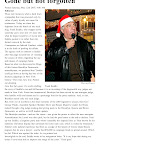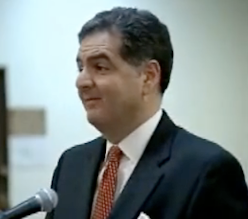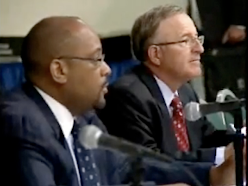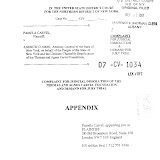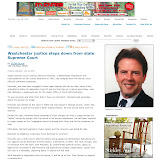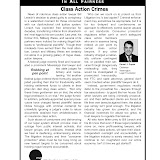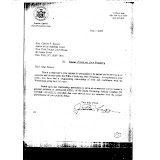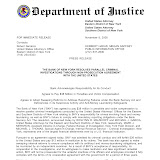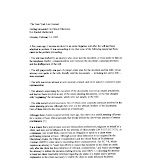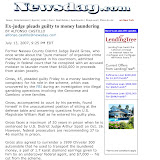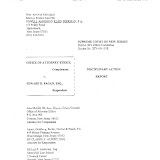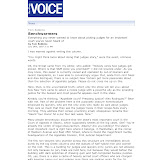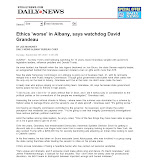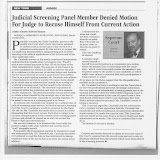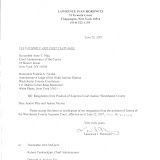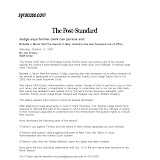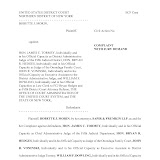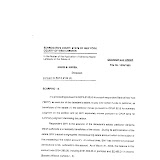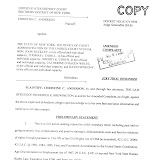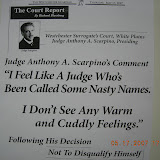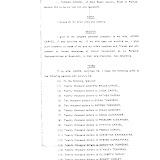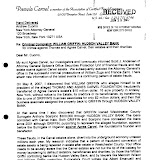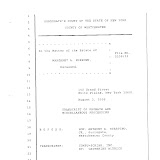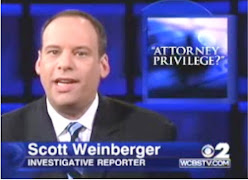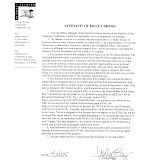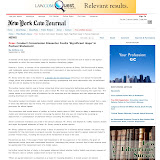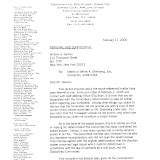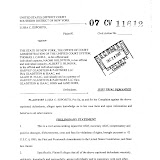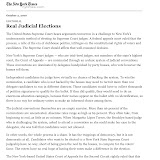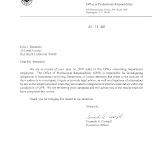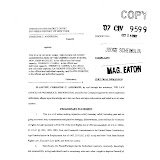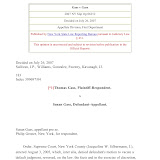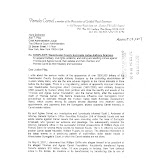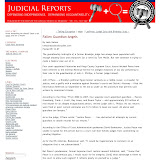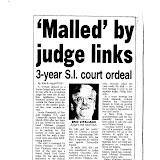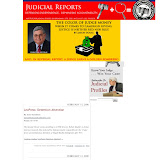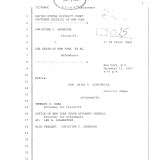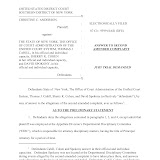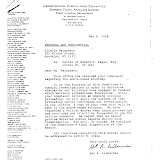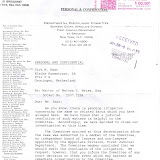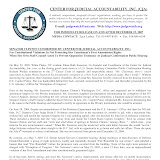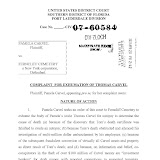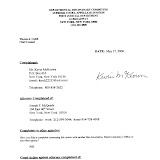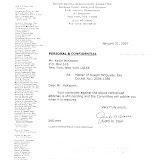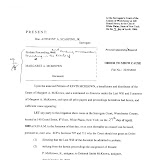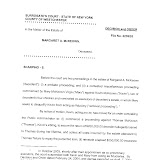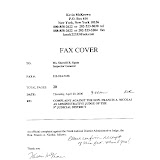NY lawyer’s decision to withdraw multimillion lottery claim doesn’t end mystery over ticket
The Associated Press - January 26, 2012
DES MOINES, Iowa — A New York attorney’s decision to withdraw his claim on a multimillion dollar Iowa Lottery prize doesn’t put to rest officials’ questions about how he obtained the ticket. Crawford Shaw, of Bedford, N.Y., withdrew his claim Thursday on a multimillion dollar Iowa Lottery prize just as mysteriously as he has made it, saying through a Des Moines law firm that he couldn’t satisfy lottery officials’ request for basic information about how he obtained the winning ticket. The lottery has asked the Iowa Division of Criminal Investigation and the Iowa attorney general to investigate. Officials say Shaw submitted the ticket for redemption on behalf of a trust on Dec. 29, less than two hours before it expired, and has identified the recipient only as a corporation in the country of Belize. The lottery wants to know how Shaw obtained the ticket to make sure it wasn’t stolen and that a valid player bought it. It has been 13 months since the winning ticket was purchased at a Des Moines gas station in December 2010. The payout for the prize would have been $7.5 million cash, or $10.3 million spread over 25 years after taxes. Iowa lottery officials had given Shaw until Friday to provide the identities and contact information of anyone who purchased or possessed the ticket. Instead of claiming the prize in person, as is normally done, Shaw signed the ticket on behalf of the trust and shipped it by FedEx to a Des Moines law firm he had retained. Shaw, 76, sent a fax to the law firm Thursday saying he doesn’t know the identity of the purchaser. The firm relayed the information to lottery officials. “In order that the claim be resolved without further controversy, Crawford Shaw, as Trustee for and on behalf of the Trust, does hereby withdraw the Claim and does hereby agree to take no further action to enforce the Claim,” the fax signed by Shaw reads. Shaw signed the ticket on behalf of Bedford, N.Y.-based Hexham Investments Trust, though lottery officials have said he misspelled the name of the trust by leaving off the second “h.” Shaw claimed not to be a beneficiary of the trust. Iowa Lottery CEO Terry Rich said Thursday that it’s the strangest situation officials can recall in the 26-year history of the lottery. He declined to speculate on the details of the claim, saying if he knew more than what’s been released, lottery officials would probably be writing a check to a winner. “I’m telling you, if I could take all of the suggestions, it would be a heck of a fun book,” Rich said. He previously had said the lottery had received several claims that the ticket was stolen. Iowa law also prohibits employees and contractors of the lottery, their relatives and anyone younger than 21 from playing. Shaw said Wednesday through the Des Moines-based Davis Brown Law Firm that if the jackpot were paid, the money would be donated to charity. He declined to comment further Thursday. Records show Shaw played at least a minor role in the collapse of Industrial Enterprises of America, a chemical company that was looted and bankrupted in 2009 by a stock manipulation scheme. Shaw helped found the company after taking control of a Houston-based shell corporation, serving as its CEO from 2004 to 2005. Shaw’s history also includes lawsuits alleging fraud in Delaware and Texas. The unclaimed money will go toward future prizes, Rich said.
MLK said: "Injustice Anywhere is a Threat to Justice Everywhere"
End Corruption in the Courts!
Court employee, judge or citizen - Report Corruption in any Court Today !! As of June 15, 2016, we've received over 142,500 tips...KEEP THEM COMING !! Email: CorruptCourts@gmail.com
Most Read Stories
- Tembeckjian's Corrupt Judicial 'Ethics' Commission Out of Control
- As NY Judges' Pay Fiasco Grows, Judicial 'Ethics' Chief Enjoys Public-Paid Perks
- New York Judges Disgraced Again
- Wall Street Journal: When our Trusted Officials Lie
- Massive Attorney Conflict in Madoff Scam
- FBI Probes Threats on Federal Witnesses in New York Ethics Scandal
- Federal Judge: "But you destroyed the faith of the people in their government."
- Attorney Gives New Meaning to Oral Argument
- Wannabe Judge Attorney Writes About Ethical Dilemmas SHE Failed to Report
- 3 Judges Covered Crony's 9/11 Donation Fraud
- Former NY State Chief Court Clerk Sues Judges in Federal Court
- Concealing the Truth at the Attorney Ethics Committee
- NY Ethics Scandal Tied to International Espionage Scheme
- Westchester Surrogate's Court's Dastardly Deeds
Friday, January 27, 2012
NY "Officer-of-the-Court" Mystery Hits Cow Country
Monday, January 23, 2012
'Occupy' Movement Protests 'Citizens United' at Supreme Court, Other U.S. Courthouses
'Occupy' Movement Protests 'Citizens United' at Supreme Court, Other U.S. Courthouses
The National Law Journal by Tony Mauro and Andrew Ramonas - January 23, 2012
WASHINGTON, DC - The "occupy" movement took its campaign against corporate domination to the federal judiciary on Jan. 20, storming the U.S. Supreme Court building and demonstrating at other courthouses nationwide to protest the high court's 2010 Citizens United decision. "Corporations are not persons, and money is not political speech!" proclaimed "Occupy the Courts" leader David Cobb in front of several hundred people at a grassy area on U.S. Capitol grounds across the street from the Supreme Court. Protesters, some of them from the Occupy Wall Street encampments in Washington, later moved across the street to the Court, where they pushed through a police barricade and ran up the Court's steps almost to the columns that guard the bronze front doors. Court police allowed the demonstrators to advance, even though federal law prohibits demonstrations on Court grounds. Finally, an hour after the protesters entered onto Court property, police began making arrests and ordering remaining demonstrators down the steps. Late in the afternoon, a Court spokeswoman said a dozen people had been arrested. The protests marked the two-year anniversary on Jan. 21 of the Supreme Court's 5-4 decision in Citizens United v. Federal Election Commission, 130 S. Ct. 876 (2010), which struck down restrictions on independent expenditures by corporation and unions in election campaigns. Critics say the ruling has injected millions of dollars into campaigns, often in the form of attack advertising funded by independent "super-PACs" that cannot be directly traced or imputed to candidates. Several leaders of the protest said coverage of the Super-PACs and their impact on the Republican presidential primaries has helped galvanize opposition. "We are seeing how this disgusting decision is corrupting our system," said Medea Benjamin of Code Pink, a longtime activist who helped organize the Jan. 20 protests. "And we ain't seen nothing yet. Wait until the races get under way, and this will be influencing congressional races, everything." Asked why she was demonstrating at the Court, she said, "This is the scene of the crime." Some of the protesters are hoping to build on the protests and push for a constitutional amendment that would overturn Citizens United by stating that money is not speech and corporations are not persons under the law. Asked if a constitutional amendment is a realistic goal, Joan Stallard, a demonstrator from Washington, said, "The Constitution has been amended 27 times, and we can do it again." She said more and more of the public is beginning to understand "the power of corporations in our political system" and will be receptive to a constitutional change. The demonstration at the high court began with some light theater—black-robed "justices" dancing and singing. In Boston, protests included speeches and music by a fife-and-drum team dressed in Revolutionary War-era clothing. An "auctioneer" dressed in top hat and tails sold rights such as free speech and freedom of the press to the highest bidders, who were corporations represented by people dressed in boxes with the names of companies. About 150 people braved 29-degree weather to participate in the Boston protest behind the John J. Moakley U.S. Courthouse. In New York City, where the "Occupy" protests began, demonstrators moved the location of their anti-court protest to Foley Square, after a federal judge on Jan. 19 rejected their preferred location outside the Daniel Patrick Moynihan courthouse. Southern District Judge Lewis Kaplan said the General Services Administration had properly denied the group's application for a permit, because the location the demonstrators sought was not a designated public forum (NYLJ, Jan. 20). Late on the afternoon of Jan. 20, approximately 50 protesters were massing on Broadway, set to march about 12 blocks from Zuccotti Park north to Foley Square for a rally. Roughly 100 people chanted slogans outside the U.S. Court of Appeals for the Ninth Circuit in San Francisco. Demonstrators also gathered in Portland, Ore. and Detroit. In Chicago, 50 demonstrators came out in driving snow, with one holding a sign that said, "Citizens United against Citizens United." Tony Mauro covers the U.S. Supreme Court for ALM, the Law Journal's parent. He can be contacted at tmauro@alm.com. Andrew Ramonas, a reporter at The National Law Journal, an affiliate, can be contacted at aramonas@alm.com. Sheri Qualters, a reporter at The National Law Journal, contributed to this report.
The National Law Journal by Tony Mauro and Andrew Ramonas - January 23, 2012
WASHINGTON, DC - The "occupy" movement took its campaign against corporate domination to the federal judiciary on Jan. 20, storming the U.S. Supreme Court building and demonstrating at other courthouses nationwide to protest the high court's 2010 Citizens United decision. "Corporations are not persons, and money is not political speech!" proclaimed "Occupy the Courts" leader David Cobb in front of several hundred people at a grassy area on U.S. Capitol grounds across the street from the Supreme Court. Protesters, some of them from the Occupy Wall Street encampments in Washington, later moved across the street to the Court, where they pushed through a police barricade and ran up the Court's steps almost to the columns that guard the bronze front doors. Court police allowed the demonstrators to advance, even though federal law prohibits demonstrations on Court grounds. Finally, an hour after the protesters entered onto Court property, police began making arrests and ordering remaining demonstrators down the steps. Late in the afternoon, a Court spokeswoman said a dozen people had been arrested. The protests marked the two-year anniversary on Jan. 21 of the Supreme Court's 5-4 decision in Citizens United v. Federal Election Commission, 130 S. Ct. 876 (2010), which struck down restrictions on independent expenditures by corporation and unions in election campaigns. Critics say the ruling has injected millions of dollars into campaigns, often in the form of attack advertising funded by independent "super-PACs" that cannot be directly traced or imputed to candidates. Several leaders of the protest said coverage of the Super-PACs and their impact on the Republican presidential primaries has helped galvanize opposition. "We are seeing how this disgusting decision is corrupting our system," said Medea Benjamin of Code Pink, a longtime activist who helped organize the Jan. 20 protests. "And we ain't seen nothing yet. Wait until the races get under way, and this will be influencing congressional races, everything." Asked why she was demonstrating at the Court, she said, "This is the scene of the crime." Some of the protesters are hoping to build on the protests and push for a constitutional amendment that would overturn Citizens United by stating that money is not speech and corporations are not persons under the law. Asked if a constitutional amendment is a realistic goal, Joan Stallard, a demonstrator from Washington, said, "The Constitution has been amended 27 times, and we can do it again." She said more and more of the public is beginning to understand "the power of corporations in our political system" and will be receptive to a constitutional change. The demonstration at the high court began with some light theater—black-robed "justices" dancing and singing. In Boston, protests included speeches and music by a fife-and-drum team dressed in Revolutionary War-era clothing. An "auctioneer" dressed in top hat and tails sold rights such as free speech and freedom of the press to the highest bidders, who were corporations represented by people dressed in boxes with the names of companies. About 150 people braved 29-degree weather to participate in the Boston protest behind the John J. Moakley U.S. Courthouse. In New York City, where the "Occupy" protests began, demonstrators moved the location of their anti-court protest to Foley Square, after a federal judge on Jan. 19 rejected their preferred location outside the Daniel Patrick Moynihan courthouse. Southern District Judge Lewis Kaplan said the General Services Administration had properly denied the group's application for a permit, because the location the demonstrators sought was not a designated public forum (NYLJ, Jan. 20). Late on the afternoon of Jan. 20, approximately 50 protesters were massing on Broadway, set to march about 12 blocks from Zuccotti Park north to Foley Square for a rally. Roughly 100 people chanted slogans outside the U.S. Court of Appeals for the Ninth Circuit in San Francisco. Demonstrators also gathered in Portland, Ore. and Detroit. In Chicago, 50 demonstrators came out in driving snow, with one holding a sign that said, "Citizens United against Citizens United." Tony Mauro covers the U.S. Supreme Court for ALM, the Law Journal's parent. He can be contacted at tmauro@alm.com. Andrew Ramonas, a reporter at The National Law Journal, an affiliate, can be contacted at aramonas@alm.com. Sheri Qualters, a reporter at The National Law Journal, contributed to this report.
Corrupt Judge-Picking Machine Upset With Law-Abiding Federal Judge
City Seeks Removal of Garaufis From Firefighter Bias Lawsuit
The New York Law Journal by Mark Hamblett - January 23, 2012
New York City took its conflict with Eastern District Judge Nicholas Garaufis to a new level on Jan. 20, announcing that it had filed an appellate brief challenging the judge's remedial order in the long running battle over discriminatory hiring practices at the Fire Department and requesting that the judge be removed from the case. "It is an understatement to say that this judge has expressed firm views on the city's ostensible intent to discriminate, as well as the supposed need for close judicial oversight of systemic relief," the brief states. "To any reasonable observer, the vehemence of those beliefs would raise substantial doubt that he could fairly re-evaluate the evidence on either issue." Incensed over Judge Garaufis' decision to name a court monitor who could serve for at least a decade, Corporation Counsel Michael Cardozo and his legal team told the U.S. Court of Appeals for the Second Circuit that Judge Garaufis had demonstrated "bias throughout the proceeding." Judge Garaufis has voided three firefighter exams and made two liability determinations based on exams, finding the FDNY guilty of both intentional discrimination against black applicants, and practices that had a disparate impact on minorities, a finding that Mr. Cardozo said in his brief "intentionally disregarded a wealth of evidence relevant to the city's lack of discriminatory intent." In October, as he issued a remedial order in United States v. The City of New York, 11-5113-cv., that included the appointment of a monitor, Judge Garaufis observed, "Today—our years of litigation and two adverse liability decisions later—the city still doesn't get it." (NYLJ, Oct. 6, 2011) Mr. Cardozo vowed to appeal "as soon as the law allows." He did so in December and asked the Second Circuit to hear the appeal on an expedited basis (NYLJ, Dec. 9, 2011).
In its brief filed with the circuit on Jan. 17, the Law Department states that Judge Garaufis abused his discretion in entering an injunctive order that "far exceeds the scope of the statutory violation." "Despite the broad equitable powers conferred by Title VII, the District Court lacked authority to order the FDNY to change practices that have nothing to do with the exams that formed the sole basis for both liability determinations," the city argues. The injunction also violates "fundamental principles of federalism," the city says, because it limits the "political branches' ability to determine the appropriate allocation of scarce public resources," a concern that is heightened where, "as here, federal courts interfere with a locality's discretion in how best to protect public safety." "Further, the FDNY's quasi-military structure demands that a firefighter respond to authority with alacrity," the brief states. "The Fire Commissioner has the duty and necessary expertise to ensure, in the exercise of his sound discretion, that individuals holding such a position have the requisite character and integrity to command public trust. "Absent a proper adjudication that he has abused that power, a federal judge may not intervene without disrupting the delicate balance guaranteed by the Constitution." The city attacked the judge's findings of fact that followed a remedial bench trial he held in August, facts that Judge Garaufis said showed that hiring practices discriminated against blacks and Hispanics, leaving the department "a stubborn bastion of white male privilege." But the city's strongest language was reserved for the judge himself. It claimed Judge Garaufis showed partiality during the hearing—a "pervasive propensity to excuse shortcomings" in the proof offered by the Vulcan Society, an organization of black firefighters who intervened in the case brought by the U.S. government. "The picture that emerges is that of a court bound and determined to justify closely supervised 'top-to-bottom' injunctive relief," the city's brief states. "Where the city's proof showed that such relief was unnecessary, the court excluded, struck or ignored it. Where intervenors' evidence fell short, the court found a way to excuse or fix it." The city's lawyers say the judge tried to bolster the intervenors' evidence by calling three city officials as witnesses, thereby making "himself a witness in the case" in violation of the Federal Rules of Evidence "and destroying the appearance of impartiality." The city faults the judge for "confrontational" questions to city witnesses, the appointment of former Manhattan district attorney Robert Morgenthau as a special master to oversee test development, (Mr. Morgenthau would later step aside to be replaced by Mary Jo White, the former Southern District U.S. attorney who is now a Debevoise & Plimpton partner), and said the judge was "influenced by press accounts of extrajudicial statements attributed to city officials." The brief quotes the judge at one point as saying, "The court has been criticized in the media by the mayor and the Office of Corporation Counsel all along in this litigation." The brief was written by Alan G. Krams and Deborah A. Brenner, senior counsels in the Appellate Division of the city Law Department. Mr. Cardozo also signed the document because of the importance of the issue, a spokesperson said. Judge Garaufis declined to comment about the brief. Richard A. Levy of Levy Ratner represents the Vulcan Society. Mr. Levy said the city "is trying to avoid injunctive relief on the theory it was predicated on the intentional discrimination finding." He added, "I think they may be disappointed. Certainly, it's our view that all of the relief that was granted could have been granted based on [the judge's] finding of disparate impact—even though no intentionality has been found." Mark Hamblett can be contacted at mhamblett@alm.com.
The New York Law Journal by Mark Hamblett - January 23, 2012
New York City took its conflict with Eastern District Judge Nicholas Garaufis to a new level on Jan. 20, announcing that it had filed an appellate brief challenging the judge's remedial order in the long running battle over discriminatory hiring practices at the Fire Department and requesting that the judge be removed from the case. "It is an understatement to say that this judge has expressed firm views on the city's ostensible intent to discriminate, as well as the supposed need for close judicial oversight of systemic relief," the brief states. "To any reasonable observer, the vehemence of those beliefs would raise substantial doubt that he could fairly re-evaluate the evidence on either issue." Incensed over Judge Garaufis' decision to name a court monitor who could serve for at least a decade, Corporation Counsel Michael Cardozo and his legal team told the U.S. Court of Appeals for the Second Circuit that Judge Garaufis had demonstrated "bias throughout the proceeding." Judge Garaufis has voided three firefighter exams and made two liability determinations based on exams, finding the FDNY guilty of both intentional discrimination against black applicants, and practices that had a disparate impact on minorities, a finding that Mr. Cardozo said in his brief "intentionally disregarded a wealth of evidence relevant to the city's lack of discriminatory intent." In October, as he issued a remedial order in United States v. The City of New York, 11-5113-cv., that included the appointment of a monitor, Judge Garaufis observed, "Today—our years of litigation and two adverse liability decisions later—the city still doesn't get it." (NYLJ, Oct. 6, 2011) Mr. Cardozo vowed to appeal "as soon as the law allows." He did so in December and asked the Second Circuit to hear the appeal on an expedited basis (NYLJ, Dec. 9, 2011).
In its brief filed with the circuit on Jan. 17, the Law Department states that Judge Garaufis abused his discretion in entering an injunctive order that "far exceeds the scope of the statutory violation." "Despite the broad equitable powers conferred by Title VII, the District Court lacked authority to order the FDNY to change practices that have nothing to do with the exams that formed the sole basis for both liability determinations," the city argues. The injunction also violates "fundamental principles of federalism," the city says, because it limits the "political branches' ability to determine the appropriate allocation of scarce public resources," a concern that is heightened where, "as here, federal courts interfere with a locality's discretion in how best to protect public safety." "Further, the FDNY's quasi-military structure demands that a firefighter respond to authority with alacrity," the brief states. "The Fire Commissioner has the duty and necessary expertise to ensure, in the exercise of his sound discretion, that individuals holding such a position have the requisite character and integrity to command public trust. "Absent a proper adjudication that he has abused that power, a federal judge may not intervene without disrupting the delicate balance guaranteed by the Constitution." The city attacked the judge's findings of fact that followed a remedial bench trial he held in August, facts that Judge Garaufis said showed that hiring practices discriminated against blacks and Hispanics, leaving the department "a stubborn bastion of white male privilege." But the city's strongest language was reserved for the judge himself. It claimed Judge Garaufis showed partiality during the hearing—a "pervasive propensity to excuse shortcomings" in the proof offered by the Vulcan Society, an organization of black firefighters who intervened in the case brought by the U.S. government. "The picture that emerges is that of a court bound and determined to justify closely supervised 'top-to-bottom' injunctive relief," the city's brief states. "Where the city's proof showed that such relief was unnecessary, the court excluded, struck or ignored it. Where intervenors' evidence fell short, the court found a way to excuse or fix it." The city's lawyers say the judge tried to bolster the intervenors' evidence by calling three city officials as witnesses, thereby making "himself a witness in the case" in violation of the Federal Rules of Evidence "and destroying the appearance of impartiality." The city faults the judge for "confrontational" questions to city witnesses, the appointment of former Manhattan district attorney Robert Morgenthau as a special master to oversee test development, (Mr. Morgenthau would later step aside to be replaced by Mary Jo White, the former Southern District U.S. attorney who is now a Debevoise & Plimpton partner), and said the judge was "influenced by press accounts of extrajudicial statements attributed to city officials." The brief quotes the judge at one point as saying, "The court has been criticized in the media by the mayor and the Office of Corporation Counsel all along in this litigation." The brief was written by Alan G. Krams and Deborah A. Brenner, senior counsels in the Appellate Division of the city Law Department. Mr. Cardozo also signed the document because of the importance of the issue, a spokesperson said. Judge Garaufis declined to comment about the brief. Richard A. Levy of Levy Ratner represents the Vulcan Society. Mr. Levy said the city "is trying to avoid injunctive relief on the theory it was predicated on the intentional discrimination finding." He added, "I think they may be disappointed. Certainly, it's our view that all of the relief that was granted could have been granted based on [the judge's] finding of disparate impact—even though no intentionality has been found." Mark Hamblett can be contacted at mhamblett@alm.com.
Lawyer's Claim of Firing for Refusal to Back Forgery Is Left to Jury
Lawyer's Claim of Firing for Refusal to Back Forgery Is Left to Jury
The New York Law Journal by Brendan Pierson - January 23, 2012
A lawsuit by a former Napoli Bern partner who claims he was fired for refusing to sign an affirmation that a forged signature was genuine may go forward, a state judge has ruled. In a Jan. 19 ruling in Connolly v. Napoli Kaiser Bern, 105224/05, Manhattan Supreme Court Justice Joan A. Madden denied a motion by the firm for summary judgment dismissing the suit, which was filed by Gerard A. Connolly. When Mr. Connolly worked at the firm, it was called Napoli Kaiser Bern. It is now called Napoli Bern Ripka Shkolnik. The suit centers on a personal injury case, Vasquez v. Barbieri, 13010/97, in Bronx Supreme Court. Mr. Connolly served as trial counsel for the plaintiff, Anthony Vasquez, in March and April 2001. According to Justice Madden's decision, Mr. Connolly began the case believing that Mr. Vasquez's wife, Rosa, had a derivative claim as a result of her husband's injury. However, he learned that the couple had separated before the injury and concluded that Ms. Vasquez had no claim. In mid-April 2001, the Vasquez case settled for $850,000, according to the decision. However, the defendant's insurer would not pay the settlement without signatures from both Mr. and Ms. Vasquez.
It is undisputed that Mr. Vasquez forged Ms. Vasquez's signature on the settlement documents. Mr. Vasquez testified in Mr. Connolly's suit that he did this at the suggestion of Gerald Kaiser, then a senior partner at the firm. Mr. Kaiser, now a director at Madison National Bancorp Inc. on Long Island, denies this and claims he did not learn the signature was forged until months later. In July 2001, the Napoli firm received a letter from an attorney representing Ms. Vasquez saying she had no knowledge of the settlement. In winter 2001, Ms. Vasquez moved to vacate the settlement. In order to oppose that motion, Mr. Kaiser asked Mr. Connolly to sign an affirmation that Ms. Vasquez had signed the settlement documents. Mr. Connolly refused on the grounds that he did not believe she had signed the documents and that, in any case, he had no personal knowledge about whether or not she had. On March 19, 2002, he signed a revised affirmation about the case, omitting that Ms. Vasquez had signed the documents. On April 11, 2002, the return date of Ms. Vasquez's motion, Ms. Vasquez reached a settlement with Mr. Vasquez and the Napoli firm in court, under which Mr. Vasquez agreed to pay her $12,000 and the firm agreed to pay her $50,000. On that same day, Napoli senior partner Marc J. Bern told Mr. Connolly that his employment was being terminated. Napoli senior partner Paul J. Napoli testified during Mr. Connolly's lawsuit that he fired Mr. Connolly because of his "sloppiness with court dates" and because he had lost five cases. He said that he had reached the decision to fire Mr. Connolly in September 2001, and that Mr. Connolly's handling of the Vasquez case was only the "culmination of his poor performance," precipitating his immediate termination. But Justice Madden held that Mr. Napoli's argument was one for a jury. "When viewing this evidence in the light most favorable to plaintiff…a reasonable fact finder could conclude that plaintiff was terminated for his refusal to sign this false affirmation in violation of [the Lawyer's Code of Professional Responsibility], rather than, as defendants allege, his poor performance as a trial attorney, and his alleged mishandling of the Vasquez action," she wrote. The judge noted that, in the two months before he was fired, Mr. Connolly had won two verdicts. In February 2002, he won a $75,000 award for an inmate who had been assaulted at Rikers Island. That March, he won a $203,000 award for a plaintiff who was injured after stepping into an open basement trap door. Mr. Connolly also obtained settlements for Napoli clients amounting to about $300,000 in winter 2001-02, according to the decision. Justice Madden also noted that Mr. Kaiser had testified that Mr. Connolly "did most aspects of his job well." "In addition, the timing of his termination suggests that plaintiff was fired not due to his alleged mishandling of the Vasquez action, but as a result of his refusal in March 2002, to falsely attest that Ms. Vasquez's signatures were genuine," she wrote. "If, in fact, NKB intended to fire plaintiff due to his mishandling of the case in connection with the signing of the release, it likely would have done soon after Ms. Vasquez's application was filed in February 2002," she said. "However, plaintiff was not terminated until the April 1, 2002 return date which was also after plaintiff refused to sign the false affirmation." "I think the court got it absolutely correct," said Andrew M. Moskowitz of Pashman Stein, counsel to Mr. Connolly. "There was ample evidence from which a reasonable jury could find that Mr. Connolly was terminated for his refusal to file a false affirmation." "We disagree with the decision and expect to take an appeal," said Christopher B. Hitchcock of Hitchcock & Cummings, counsel to Napoli Bern. Mr. Bern referred a request for comment to his outside counsel, who could not immediately be reached. Brendan Pierson can be contacted at bpierson@alm.com.
The New York Law Journal by Brendan Pierson - January 23, 2012
A lawsuit by a former Napoli Bern partner who claims he was fired for refusing to sign an affirmation that a forged signature was genuine may go forward, a state judge has ruled. In a Jan. 19 ruling in Connolly v. Napoli Kaiser Bern, 105224/05, Manhattan Supreme Court Justice Joan A. Madden denied a motion by the firm for summary judgment dismissing the suit, which was filed by Gerard A. Connolly. When Mr. Connolly worked at the firm, it was called Napoli Kaiser Bern. It is now called Napoli Bern Ripka Shkolnik. The suit centers on a personal injury case, Vasquez v. Barbieri, 13010/97, in Bronx Supreme Court. Mr. Connolly served as trial counsel for the plaintiff, Anthony Vasquez, in March and April 2001. According to Justice Madden's decision, Mr. Connolly began the case believing that Mr. Vasquez's wife, Rosa, had a derivative claim as a result of her husband's injury. However, he learned that the couple had separated before the injury and concluded that Ms. Vasquez had no claim. In mid-April 2001, the Vasquez case settled for $850,000, according to the decision. However, the defendant's insurer would not pay the settlement without signatures from both Mr. and Ms. Vasquez.
It is undisputed that Mr. Vasquez forged Ms. Vasquez's signature on the settlement documents. Mr. Vasquez testified in Mr. Connolly's suit that he did this at the suggestion of Gerald Kaiser, then a senior partner at the firm. Mr. Kaiser, now a director at Madison National Bancorp Inc. on Long Island, denies this and claims he did not learn the signature was forged until months later. In July 2001, the Napoli firm received a letter from an attorney representing Ms. Vasquez saying she had no knowledge of the settlement. In winter 2001, Ms. Vasquez moved to vacate the settlement. In order to oppose that motion, Mr. Kaiser asked Mr. Connolly to sign an affirmation that Ms. Vasquez had signed the settlement documents. Mr. Connolly refused on the grounds that he did not believe she had signed the documents and that, in any case, he had no personal knowledge about whether or not she had. On March 19, 2002, he signed a revised affirmation about the case, omitting that Ms. Vasquez had signed the documents. On April 11, 2002, the return date of Ms. Vasquez's motion, Ms. Vasquez reached a settlement with Mr. Vasquez and the Napoli firm in court, under which Mr. Vasquez agreed to pay her $12,000 and the firm agreed to pay her $50,000. On that same day, Napoli senior partner Marc J. Bern told Mr. Connolly that his employment was being terminated. Napoli senior partner Paul J. Napoli testified during Mr. Connolly's lawsuit that he fired Mr. Connolly because of his "sloppiness with court dates" and because he had lost five cases. He said that he had reached the decision to fire Mr. Connolly in September 2001, and that Mr. Connolly's handling of the Vasquez case was only the "culmination of his poor performance," precipitating his immediate termination. But Justice Madden held that Mr. Napoli's argument was one for a jury. "When viewing this evidence in the light most favorable to plaintiff…a reasonable fact finder could conclude that plaintiff was terminated for his refusal to sign this false affirmation in violation of [the Lawyer's Code of Professional Responsibility], rather than, as defendants allege, his poor performance as a trial attorney, and his alleged mishandling of the Vasquez action," she wrote. The judge noted that, in the two months before he was fired, Mr. Connolly had won two verdicts. In February 2002, he won a $75,000 award for an inmate who had been assaulted at Rikers Island. That March, he won a $203,000 award for a plaintiff who was injured after stepping into an open basement trap door. Mr. Connolly also obtained settlements for Napoli clients amounting to about $300,000 in winter 2001-02, according to the decision. Justice Madden also noted that Mr. Kaiser had testified that Mr. Connolly "did most aspects of his job well." "In addition, the timing of his termination suggests that plaintiff was fired not due to his alleged mishandling of the Vasquez action, but as a result of his refusal in March 2002, to falsely attest that Ms. Vasquez's signatures were genuine," she wrote. "If, in fact, NKB intended to fire plaintiff due to his mishandling of the case in connection with the signing of the release, it likely would have done soon after Ms. Vasquez's application was filed in February 2002," she said. "However, plaintiff was not terminated until the April 1, 2002 return date which was also after plaintiff refused to sign the false affirmation." "I think the court got it absolutely correct," said Andrew M. Moskowitz of Pashman Stein, counsel to Mr. Connolly. "There was ample evidence from which a reasonable jury could find that Mr. Connolly was terminated for his refusal to file a false affirmation." "We disagree with the decision and expect to take an appeal," said Christopher B. Hitchcock of Hitchcock & Cummings, counsel to Napoli Bern. Mr. Bern referred a request for comment to his outside counsel, who could not immediately be reached. Brendan Pierson can be contacted at bpierson@alm.com.
Bad Justice Getting Slower
Getting a divorce? Better not be in a hurry
The Staten Island Advance by Frank Donnelly - www.SiLive.com - January 22, 2012
STATEN ISLAND, N.Y. -- Divorce cases are among the most gut-wrenching and contentious on Staten Island court dockets, and to the dismay of litigants and their lawyers, they're taking longer to resolve. Budget cuts and layoffs in the court system are prime culprits for the delays, although the sagging economy also plays a role, say lawyers. Veteran matrimonial attorney William J. Leininger said the wait to obtain a signed judgment finalizing a divorce is now nine months or more after both sides agree to terms. The finalization process used to take three or four months, he said. And that's on top of the time typically required -- anywhere from a few months to two years -- to reach the divorce settlement. The delays have pushed back clients' re-marriages and even cost some their wedding-hall deposits, said Leininger. The settlement stipulation, which establishes alimony, child support, custody and other issues, is unenforceable without the signed judgment, he said. And parties can't legally re-marry without the judgment. "It's a major problem. People want to move on with their lives," said Leininger, whose practice is based in Dongan Hills. "People have no legal rights when the judgment hasn't been signed. My clients have had their rights put into limbo for 10 months. It's very sad." According to the New York City Bar Association, the state judiciary, last year, was subjected to a $170 million budget cut. About 8 percent of its workforce, or 1,300 employees, left the courts due to early retirements and layoffs. As a result of those reductions, all courtrooms throughout the state must stop all activities at 4:30 p.m., including trials, settlement conferences and meetings with lawyers. On Staten Island, former administrative judge Philip G. Minardo said he had to shave off about $750,000, or around 5 percent, from the Supreme Court's $15.5 million budget for the current fiscal year and still keep the court running efficiently. Anne-Louise DePalo, a Dongan Hills-based matrimonial lawyer, said cutbacks had limited the matrimonial part to one clerk to review documents in contested divorce cases. Those records, which include financials, are typically voluminous. "It was a time-consuming process," she said. "It's not the court's fault. They have limitations in staffing. [But] if people don't settle their cases, it can take a long time" to resolve them. Justice Judith N. McMahon, who replaced Minardo on Jan. 1 as administrative judge, acknowledged that budget cuts and personnel losses have slowed divorce-case resolutions. She's vowed to expedite the process. "There have been resources transferred to the matrimonial part," she said last week. "I can tell you the entire staff in the matrimonial part is working very hard to decrease any type of delay, but, sometimes, it's innate in the matrimonial part. It's my belief that we should be up to date as of the end of March." Graniteville-based matrimonial lawyer Valerie J. Camacho believes the country's lingering financial crisis has played a main role in dragging out divorce cases here. "I think it's more a function of the economy," she said. "It's just harder to resolve cases. When you have enough money for both parties to divide assets, it's easy. But in this economy, it's almost impossible to divide up the assets so that both parties can survive." On the other hand, Paul Scano, a Castleton Corners-based matrimonial lawyer, said he hasn't noticed any significant slowdown in resolving cases. "Delays in signing judgments of divorce have gone on for a long time," he said. "It's nothing new." But both Scano and Leininger said New Jersey has streamlined the process to finalize divorces, and they'd like to see New York adopt it. In the Garden State, judges sign the final judgment of divorce in court when the two sides present it, along with the signed stipulation of settlement, setting forth the divorce terms, said Leininger. In New York, however, the plaintiff's attorney must prepare the final judgment notice after the settlement is discussed in court with the judge. He must then serve a copy of the judgment on the opposing lawyer and file the original with the matrimonial clerk's office where it can linger nine months or more before being signed, said Leininger. Leininger said 98 percent of divorces here are settled without a trial, so the New Jersey method would speed up the vast bulk of cases. He said it would require state court administrators' approval to implement. Judge McMahon said the re-jiggering of court personnel should move cases along. "The judgments are being done in a much more expeditious manner now," she said.
The Staten Island Advance by Frank Donnelly - www.SiLive.com - January 22, 2012
STATEN ISLAND, N.Y. -- Divorce cases are among the most gut-wrenching and contentious on Staten Island court dockets, and to the dismay of litigants and their lawyers, they're taking longer to resolve. Budget cuts and layoffs in the court system are prime culprits for the delays, although the sagging economy also plays a role, say lawyers. Veteran matrimonial attorney William J. Leininger said the wait to obtain a signed judgment finalizing a divorce is now nine months or more after both sides agree to terms. The finalization process used to take three or four months, he said. And that's on top of the time typically required -- anywhere from a few months to two years -- to reach the divorce settlement. The delays have pushed back clients' re-marriages and even cost some their wedding-hall deposits, said Leininger. The settlement stipulation, which establishes alimony, child support, custody and other issues, is unenforceable without the signed judgment, he said. And parties can't legally re-marry without the judgment. "It's a major problem. People want to move on with their lives," said Leininger, whose practice is based in Dongan Hills. "People have no legal rights when the judgment hasn't been signed. My clients have had their rights put into limbo for 10 months. It's very sad." According to the New York City Bar Association, the state judiciary, last year, was subjected to a $170 million budget cut. About 8 percent of its workforce, or 1,300 employees, left the courts due to early retirements and layoffs. As a result of those reductions, all courtrooms throughout the state must stop all activities at 4:30 p.m., including trials, settlement conferences and meetings with lawyers. On Staten Island, former administrative judge Philip G. Minardo said he had to shave off about $750,000, or around 5 percent, from the Supreme Court's $15.5 million budget for the current fiscal year and still keep the court running efficiently. Anne-Louise DePalo, a Dongan Hills-based matrimonial lawyer, said cutbacks had limited the matrimonial part to one clerk to review documents in contested divorce cases. Those records, which include financials, are typically voluminous. "It was a time-consuming process," she said. "It's not the court's fault. They have limitations in staffing. [But] if people don't settle their cases, it can take a long time" to resolve them. Justice Judith N. McMahon, who replaced Minardo on Jan. 1 as administrative judge, acknowledged that budget cuts and personnel losses have slowed divorce-case resolutions. She's vowed to expedite the process. "There have been resources transferred to the matrimonial part," she said last week. "I can tell you the entire staff in the matrimonial part is working very hard to decrease any type of delay, but, sometimes, it's innate in the matrimonial part. It's my belief that we should be up to date as of the end of March." Graniteville-based matrimonial lawyer Valerie J. Camacho believes the country's lingering financial crisis has played a main role in dragging out divorce cases here. "I think it's more a function of the economy," she said. "It's just harder to resolve cases. When you have enough money for both parties to divide assets, it's easy. But in this economy, it's almost impossible to divide up the assets so that both parties can survive." On the other hand, Paul Scano, a Castleton Corners-based matrimonial lawyer, said he hasn't noticed any significant slowdown in resolving cases. "Delays in signing judgments of divorce have gone on for a long time," he said. "It's nothing new." But both Scano and Leininger said New Jersey has streamlined the process to finalize divorces, and they'd like to see New York adopt it. In the Garden State, judges sign the final judgment of divorce in court when the two sides present it, along with the signed stipulation of settlement, setting forth the divorce terms, said Leininger. In New York, however, the plaintiff's attorney must prepare the final judgment notice after the settlement is discussed in court with the judge. He must then serve a copy of the judgment on the opposing lawyer and file the original with the matrimonial clerk's office where it can linger nine months or more before being signed, said Leininger. Leininger said 98 percent of divorces here are settled without a trial, so the New Jersey method would speed up the vast bulk of cases. He said it would require state court administrators' approval to implement. Judge McMahon said the re-jiggering of court personnel should move cases along. "The judgments are being done in a much more expeditious manner now," she said.
Sunday, January 22, 2012
Report Finds Court Cuts Cause 'Substantial Harm'
Report Finds Budget Cuts Result in 'Substantial Harm' to Courts
The New York Law Journal by Joel Stashenko - January 19, 2012
ALBANY, NY - Budget cuts imposed on New York's state's Judiciary in 2011 have been "substantially harmful and far-reaching" to the operations of the courts, the New York State Bar Association concluded in a report released Jan. 18. The report, based on observations by litigants, lawyers and others, found that courts have been "less efficient" and that "judicial decision-making is less expedient" than before passage of the 2011-12 state budget, when $170 million was excised from the Judiciary budget of about $2.3 billion for the year beginning April 1, 2011. "Recent reductions in state court funding have been quite costly," the report says. "Although state fiscal constraints are very real in this economy, additional and imminent investment in the state court system is necessary. It is necessary to restore a sense of confidence in the judicial system, which ultimately is priceless." The report was prepared by the executive committee of the state bar based on a questionnaire it sent to lawyers, judges, court staffers and members of the public in the state's 13 judicial districts. It was released in preparation for a presidential "summit" at the upcoming annual state bar meeting at 2 p.m. on Jan. 25 at the New York Hilton in Manhattan. Former Chief Judge Judith S. Kaye and Judge Richard Wesley of the U.S. Court of Appeals for the Second Circuit will moderate the discussion about cuts in funding to federal and state courts. The president of the American Bar Association, William T. Robinson III, also is set to speak at the session on funding shortages. Vincent E. Doyle III, the president of the state bar, said on Jan. 18 that he wanted one of the presentations to focus on what he thinks is a growing crisis in funding for state courts. (The other session, to begin at 3:30 p.m. on Jan. 25, will focus on the obligations of defense attorneys to warn immigrants about the collateral consequences of conviction.)
New York's Judiciary has submitted a budget for 2012-13 that is down slightly overall but includes $27.7 million necessary for judges to receive their first raises since January 1999. Governor Andrew M. Cuomo reacted positively to the courts' spending plans in his budget proposal (NYLJ, Jan. 18). "We certainly support it," Mr. Doyle said of the Judiciary's request for 2012-13. "But we would love to see it at a higher level of funding." Mr. Doyle said the state bar wants Mr. Cuomo and legislators to understand that several years of flat budget proposals have had a "very noticeable impact on the functioning of the court system." Among the impressions gathered by the state bar is that the cutbacks have "led to delays in the administration of justice, increased costs to litigants, and the crowding of court dockets." With cases taking longer to adjudicate, the state bar said the reputation of the courts has suffered. "It results in less accessibility, loss of respect and diminished power," the report declares. Among the functions taking longer are signing off on uncontested divorces, even where no children are involved, and disposing of commercial matters, the report states. "Reductions in staff have caused delays in courthouse operations," it says. "Something as simple as getting into the courthouse takes much longer due to fewer security personnel, and long lines form that can make a litigant miss a calendar call. The filing and processing of petitions, motions, and other court filings have been slowed." The evidence is anecdotal, and the report offers no statistics about the magnitude of the delays or how much they have increased in the last year. Lise Bang-Jensen, a spokeswoman for the state bar, said it was not practical for the group to perform a more scientific survey of court consumers. "It would be impossible to collect that data," she said. "How do you quantify how many people did not get into court because of the 4:30 p.m. closing time? How many people were unhappy because they did not get to be heard by 4:30 p.m. and could not come back the next day? There is no way to significantly measure this." Mr. Doyle, of Connors & Vilardo in Buffalo, said he expects his organization and other bar groups, such as the New York City Bar and the New York County Lawyers' Association, to be more aggressive this year in promoting the next state court budget than in the previous few years. Mr. Doyle said that will include joint news conferences like the one the state bar ran last year in conjunction with the city bar, NYCLA and other groups promoting passage of bills legalizing same-sex marriage and toughening ethics legislation for public officials in New York. Both of those bills ultimately passed last year in Albany. Mr. Cuomo's office had no immediate response yesterday to the state bar's survey. Legislative leaders also had no immediate comment. The state bar's conclusions mirror the findings of a shorter New York City Bar report that found the operations of the state courts have suffered from the 2011 cutbacks (NYLJ, Jan. 10). Joel Stashenko can be contacted at jstashenko@alm.com.
The New York Law Journal by Joel Stashenko - January 19, 2012
ALBANY, NY - Budget cuts imposed on New York's state's Judiciary in 2011 have been "substantially harmful and far-reaching" to the operations of the courts, the New York State Bar Association concluded in a report released Jan. 18. The report, based on observations by litigants, lawyers and others, found that courts have been "less efficient" and that "judicial decision-making is less expedient" than before passage of the 2011-12 state budget, when $170 million was excised from the Judiciary budget of about $2.3 billion for the year beginning April 1, 2011. "Recent reductions in state court funding have been quite costly," the report says. "Although state fiscal constraints are very real in this economy, additional and imminent investment in the state court system is necessary. It is necessary to restore a sense of confidence in the judicial system, which ultimately is priceless." The report was prepared by the executive committee of the state bar based on a questionnaire it sent to lawyers, judges, court staffers and members of the public in the state's 13 judicial districts. It was released in preparation for a presidential "summit" at the upcoming annual state bar meeting at 2 p.m. on Jan. 25 at the New York Hilton in Manhattan. Former Chief Judge Judith S. Kaye and Judge Richard Wesley of the U.S. Court of Appeals for the Second Circuit will moderate the discussion about cuts in funding to federal and state courts. The president of the American Bar Association, William T. Robinson III, also is set to speak at the session on funding shortages. Vincent E. Doyle III, the president of the state bar, said on Jan. 18 that he wanted one of the presentations to focus on what he thinks is a growing crisis in funding for state courts. (The other session, to begin at 3:30 p.m. on Jan. 25, will focus on the obligations of defense attorneys to warn immigrants about the collateral consequences of conviction.)
New York's Judiciary has submitted a budget for 2012-13 that is down slightly overall but includes $27.7 million necessary for judges to receive their first raises since January 1999. Governor Andrew M. Cuomo reacted positively to the courts' spending plans in his budget proposal (NYLJ, Jan. 18). "We certainly support it," Mr. Doyle said of the Judiciary's request for 2012-13. "But we would love to see it at a higher level of funding." Mr. Doyle said the state bar wants Mr. Cuomo and legislators to understand that several years of flat budget proposals have had a "very noticeable impact on the functioning of the court system." Among the impressions gathered by the state bar is that the cutbacks have "led to delays in the administration of justice, increased costs to litigants, and the crowding of court dockets." With cases taking longer to adjudicate, the state bar said the reputation of the courts has suffered. "It results in less accessibility, loss of respect and diminished power," the report declares. Among the functions taking longer are signing off on uncontested divorces, even where no children are involved, and disposing of commercial matters, the report states. "Reductions in staff have caused delays in courthouse operations," it says. "Something as simple as getting into the courthouse takes much longer due to fewer security personnel, and long lines form that can make a litigant miss a calendar call. The filing and processing of petitions, motions, and other court filings have been slowed." The evidence is anecdotal, and the report offers no statistics about the magnitude of the delays or how much they have increased in the last year. Lise Bang-Jensen, a spokeswoman for the state bar, said it was not practical for the group to perform a more scientific survey of court consumers. "It would be impossible to collect that data," she said. "How do you quantify how many people did not get into court because of the 4:30 p.m. closing time? How many people were unhappy because they did not get to be heard by 4:30 p.m. and could not come back the next day? There is no way to significantly measure this." Mr. Doyle, of Connors & Vilardo in Buffalo, said he expects his organization and other bar groups, such as the New York City Bar and the New York County Lawyers' Association, to be more aggressive this year in promoting the next state court budget than in the previous few years. Mr. Doyle said that will include joint news conferences like the one the state bar ran last year in conjunction with the city bar, NYCLA and other groups promoting passage of bills legalizing same-sex marriage and toughening ethics legislation for public officials in New York. Both of those bills ultimately passed last year in Albany. Mr. Cuomo's office had no immediate response yesterday to the state bar's survey. Legislative leaders also had no immediate comment. The state bar's conclusions mirror the findings of a shorter New York City Bar report that found the operations of the state courts have suffered from the 2011 cutbacks (NYLJ, Jan. 10). Joel Stashenko can be contacted at jstashenko@alm.com.
Saturday, January 21, 2012
Toodles, Judge Poodle
Toodles, Judge Poodle
The New York Post - EDITORIAL - January 21, 2012
Speaking of out-of-control judges, it’s au revoir for state Supreme Court Justice Emily Jane Goodman — the leftist lapdog we dubbed Judge Poodle for her slavish devotion to the city’s bleeding-heart brigade. Goodman is calling it quits after a nearly 30-year career on the bench. She calls it retirement. We would say she’s merely formalizing a partnership she’s long maintained with — speaking of dogs — the legal beagles of the loony left. It seems that Goodman is founding a law firm with former NYCLU chief Norman Siegel and two other leftist gadflies. Her chamber doors were always open to such activists: She literally held court in her living room for the Legal Aid Society one night in 1998 to block a set of rent-law reforms from taking effect — the very essence of a judge legislating from the bench.
Here’s some of her greatest hits:
Free Rides: In 1998, she tried to undo the city’s workfare reforms by allowing welfare recipients to essentially call in sick. In 2001, at the behest of the group Housing Works, she held the city in contempt and ordered it to pay fines for not finding shelter quickly enough for five homeless AIDS patients — never mind that the city had done so speedily for more than 8,000 patients already that year. More recently, in 2010, she tossed even the most modest reforms of rent regulations that have strangled the city’s real-estate market and kept prices artificially low.
Crime: The NYPD led a two-year investigation of the Sound Factory, a notorious West Side nightclub and drug den where 20 patrons overdosed and two died. Cops raided it in 2003, but Goodman laughed off their evidence and ordered the club re-opened. The party ended in 2004 only after the feds busted in on what they called a “stash house” for ecstasy and crystal meth. Most recently, Goodman was caught displaying an official NYPD placard in her car so she could park illegally at expired meters near her apartment. Respect for the law? Not Judge Poodle. Doggone good thing she’s leaving.
The New York Post - EDITORIAL - January 21, 2012
Speaking of out-of-control judges, it’s au revoir for state Supreme Court Justice Emily Jane Goodman — the leftist lapdog we dubbed Judge Poodle for her slavish devotion to the city’s bleeding-heart brigade. Goodman is calling it quits after a nearly 30-year career on the bench. She calls it retirement. We would say she’s merely formalizing a partnership she’s long maintained with — speaking of dogs — the legal beagles of the loony left. It seems that Goodman is founding a law firm with former NYCLU chief Norman Siegel and two other leftist gadflies. Her chamber doors were always open to such activists: She literally held court in her living room for the Legal Aid Society one night in 1998 to block a set of rent-law reforms from taking effect — the very essence of a judge legislating from the bench.
Here’s some of her greatest hits:
Free Rides: In 1998, she tried to undo the city’s workfare reforms by allowing welfare recipients to essentially call in sick. In 2001, at the behest of the group Housing Works, she held the city in contempt and ordered it to pay fines for not finding shelter quickly enough for five homeless AIDS patients — never mind that the city had done so speedily for more than 8,000 patients already that year. More recently, in 2010, she tossed even the most modest reforms of rent regulations that have strangled the city’s real-estate market and kept prices artificially low.
Crime: The NYPD led a two-year investigation of the Sound Factory, a notorious West Side nightclub and drug den where 20 patrons overdosed and two died. Cops raided it in 2003, but Goodman laughed off their evidence and ordered the club re-opened. The party ended in 2004 only after the feds busted in on what they called a “stash house” for ecstasy and crystal meth. Most recently, Goodman was caught displaying an official NYPD placard in her car so she could park illegally at expired meters near her apartment. Respect for the law? Not Judge Poodle. Doggone good thing she’s leaving.
Friday, January 20, 2012
People Who Pick Political Puppet Judges Shouldn't Complain
Bloomberg slams Garaufis over FDNY discrimination ruling
The New York Post by Mitchel Maddux - January 20, 2012
Mayor Bloomberg has launched a stinging broadside against a federal judge who last year mandated broader judicial oversight over New York City's fire department after that ruling minority firefighters were subjected to widespread discrimination. City attorneys have suggested that Brooklyn federal Judge Nicholas Garaufis "abandoned a neutral role" while presiding over the civil rights case brought against the FDNY by the US Justice Department and "injected" personal, "extrajudicial beliefs" into the bitterly fought court battle. "The whole episode speaks volumes about the Court’s lack of detachment," attorneys wrote in a brief filed with the Second Circuit Court of Appeals. It is not the first time that New York City's mayor has cross rhetorical swords with the powerful federal judge who recently ordered that a court-appointed monitor should supervise a wide range of functions at the fire department involving the hiring and promotion of minority firefighters. In his written decision issued last fall, Garaufis singled out Bloomberg personally for his failure to attack the issue of bias in the FDNY's ranks head-on. Last year, the judge wrote in another opinion that the fire department and city officials had tried to downplay problem, saying "the city’s culture of bureaucratic blame-shifting and accountability avoidance [shows]...that the city does not want to be held accountable for the results of its recruitment efforts. This is unacceptable." The city's appeal in the FDNY discrimination case has been long awaited and was promised within minutes of the judge's ruling that minorities trying to become city firefighters suffer disadvantages that go far beyond the applicant testing process. The ruling placing a court-appointed monitor over the fire department followed a special bench trial held last summer, which focused on how the FDNY can attract more minority applicants to an agency overwhelmingly staffed by white firefighters. The judge concluded after the trial that the low percentage of minorities in the FDNY is "a direct result and vestige of the city’s pattern and practice of discrimination against black firefighter candidates." Garaufis' ruling stems from a 2007 lawsuit filed against the fire department by the US Justice Department, with the aim of forcing the city to hire more minorities at an agency where white men make up 93 percent of the 11,000 firefighters in its ranks - in a city with a far more diverse population. The judge had ruled previously that the FDNY's entrance test unfairly discriminates against black and Hispanic applicants. Mary Jo White, the former Manhattan US attorney appointed by the court as a special master to create a new FDNY entrance exam, has been engaged in efforts to create a new test that is more fair to minority firefighters. Firefighter applicants are scheduled to take the new test in the spring.
The New York Post by Mitchel Maddux - January 20, 2012
Mayor Bloomberg has launched a stinging broadside against a federal judge who last year mandated broader judicial oversight over New York City's fire department after that ruling minority firefighters were subjected to widespread discrimination. City attorneys have suggested that Brooklyn federal Judge Nicholas Garaufis "abandoned a neutral role" while presiding over the civil rights case brought against the FDNY by the US Justice Department and "injected" personal, "extrajudicial beliefs" into the bitterly fought court battle. "The whole episode speaks volumes about the Court’s lack of detachment," attorneys wrote in a brief filed with the Second Circuit Court of Appeals. It is not the first time that New York City's mayor has cross rhetorical swords with the powerful federal judge who recently ordered that a court-appointed monitor should supervise a wide range of functions at the fire department involving the hiring and promotion of minority firefighters. In his written decision issued last fall, Garaufis singled out Bloomberg personally for his failure to attack the issue of bias in the FDNY's ranks head-on. Last year, the judge wrote in another opinion that the fire department and city officials had tried to downplay problem, saying "the city’s culture of bureaucratic blame-shifting and accountability avoidance [shows]...that the city does not want to be held accountable for the results of its recruitment efforts. This is unacceptable." The city's appeal in the FDNY discrimination case has been long awaited and was promised within minutes of the judge's ruling that minorities trying to become city firefighters suffer disadvantages that go far beyond the applicant testing process. The ruling placing a court-appointed monitor over the fire department followed a special bench trial held last summer, which focused on how the FDNY can attract more minority applicants to an agency overwhelmingly staffed by white firefighters. The judge concluded after the trial that the low percentage of minorities in the FDNY is "a direct result and vestige of the city’s pattern and practice of discrimination against black firefighter candidates." Garaufis' ruling stems from a 2007 lawsuit filed against the fire department by the US Justice Department, with the aim of forcing the city to hire more minorities at an agency where white men make up 93 percent of the 11,000 firefighters in its ranks - in a city with a far more diverse population. The judge had ruled previously that the FDNY's entrance test unfairly discriminates against black and Hispanic applicants. Mary Jo White, the former Manhattan US attorney appointed by the court as a special master to create a new FDNY entrance exam, has been engaged in efforts to create a new test that is more fair to minority firefighters. Firefighter applicants are scheduled to take the new test in the spring.
Thursday, January 19, 2012
Special Prosecutor Possible in Judicial Misconduct Case
Special prosecutor possible in the Brunswick judge misconduct case
The Florida Times-Union by Teresa Stepzinski and Terry Dickson - December 21, 2011 (updated January 10, 2012)
Amanda Williams is resigning effective Jan. 2 amid 14 counts of misconduct.
BRUNSWICK, FL - A special prosecutor might be appointed to determine if Chief Superior Court Judge Amanda F. Williams committed a crime while being investigated for judicial misconduct. The state Attorney General’s Office wants to examine the Judicial Qualification Commission’s evidence that Williams lied to its investigators, and violated her oath of office, both of which are felony crimes. Lauren Kane, spokeswoman for Attorney General Sam Olens, said the office will decide whether to appoint a special prosecutor after talking to commission officials. If appointed, the special prosecutor would determine whether criminal charges would be filed. Facing 14 counts of unethical conduct on the bench, Williams submitted her resignation this week, effective Jan. 2. Had she not resigned, the commission would have conducted a hearing on the charges and could have asked the state Supreme Court to remove her from the bench. Among other things, Williams was accused of imposing indefinite jail terms on defendants, especially those in drug court, giving favorable treatment to the family of friends and those with high social standing, depriving defendants of access to their lawyers and ruling without giving parties a chance to be heard. With her resignation and an agreement to never again return to the bench, the commission dismissed all of the ethics charges against her. A conviction of a felony would mean Williams, 65, would lose her state pension, about $74,000 a year. As a judge, she was paid an annual state salary of $120,252. She will immediately lose the local supplements paid by the five counties in the Brunswick Judicial Circuit. Glynn County alone pays Superior Court judges $21,600 a year. Jackie Johnson, district attorney of the Brunswick Judicial Circuit, previously recused her office from any action in the case, Kane confirmed. Johnson said she did this because the commission might have called staff members as witnesses. However, one of the charges against Williams was that she held a reception for Johnson at her home in April 2009 at which she endorsed Johnson for the district attorney’s job. Johnson has said, to her knowledge, Williams made no such endorsement. terry.dickson@jacksonville.com, (912) 264-0405 - teresa.stepzinski@jacksonville.com, (904) 359-4075
The Florida Times-Union by Teresa Stepzinski and Terry Dickson - December 21, 2011 (updated January 10, 2012)
Amanda Williams is resigning effective Jan. 2 amid 14 counts of misconduct.
BRUNSWICK, FL - A special prosecutor might be appointed to determine if Chief Superior Court Judge Amanda F. Williams committed a crime while being investigated for judicial misconduct. The state Attorney General’s Office wants to examine the Judicial Qualification Commission’s evidence that Williams lied to its investigators, and violated her oath of office, both of which are felony crimes. Lauren Kane, spokeswoman for Attorney General Sam Olens, said the office will decide whether to appoint a special prosecutor after talking to commission officials. If appointed, the special prosecutor would determine whether criminal charges would be filed. Facing 14 counts of unethical conduct on the bench, Williams submitted her resignation this week, effective Jan. 2. Had she not resigned, the commission would have conducted a hearing on the charges and could have asked the state Supreme Court to remove her from the bench. Among other things, Williams was accused of imposing indefinite jail terms on defendants, especially those in drug court, giving favorable treatment to the family of friends and those with high social standing, depriving defendants of access to their lawyers and ruling without giving parties a chance to be heard. With her resignation and an agreement to never again return to the bench, the commission dismissed all of the ethics charges against her. A conviction of a felony would mean Williams, 65, would lose her state pension, about $74,000 a year. As a judge, she was paid an annual state salary of $120,252. She will immediately lose the local supplements paid by the five counties in the Brunswick Judicial Circuit. Glynn County alone pays Superior Court judges $21,600 a year. Jackie Johnson, district attorney of the Brunswick Judicial Circuit, previously recused her office from any action in the case, Kane confirmed. Johnson said she did this because the commission might have called staff members as witnesses. However, one of the charges against Williams was that she held a reception for Johnson at her home in April 2009 at which she endorsed Johnson for the district attorney’s job. Johnson has said, to her knowledge, Williams made no such endorsement. terry.dickson@jacksonville.com, (912) 264-0405 - teresa.stepzinski@jacksonville.com, (904) 359-4075
Wednesday, January 18, 2012
Disciplinary Hearing Against Bronx Surrogate Concludes
Disciplinary Hearing Against Bronx Surrogate Concludes
The New York Law Journal by Brendan Pierson - January 18, 2012
The disciplinary hearing against Bronx Surrogate Lee L. Holzman concluded on Jan. 17, more than one year after the Commission on Judicial Conduct first accused the surrogate of allowing Michael Lippman, former chief counsel to the Bronx public administrator, to collect more than $300,000 in excessive legal fees from estates. Former Manhattan Supreme Court Justice Felice K. Shea presided over the hearing, which concluded with commission attorney Brenda Correa cross-examining Surrogate Holzman for nearly two full days. Throughout the cross-examination, the surrogate repeatedly said that he had been inclined to trust affidavits of legal services submitted by Mr. Lippman, who had worked for the public administrator's office for over 30 years. He testified that, even after Mr. Lippman confessed in 2006 that he had taken excess fees from some estates, he did not believe the attorney had broken any laws and trusted that he would pay them back. He said his first inkling that Mr. Lippman may have been guilty of serious misconduct came in 2009, when state and federal authorities began investigating him. Although Surrogate Holzman removed Mr. Lippman from his position as chief counsel in 2006, he allowed him to continue working for the public administrator and to collect fees in order to refund the estates to which he owed money. The commission is charging the surrogate should have turned Mr. Lippman in to criminal authorities right away. The commission also alleges that the surrogate routinely approved legal fees for Mr. Lippman based on boilerplate language, and that he should have known about the excessive fees earlier. Both sides will now submit written closing briefs. Surrogate Holzman is represented by David Godosky of Godosky & Gentile. Ms. Shea will issue a report to the commission. The agency's administrator and Surrogate Holzman will then submit briefs to the commission, which will hear oral argument before rendering a final determination.
The New York Law Journal by Brendan Pierson - January 18, 2012
The disciplinary hearing against Bronx Surrogate Lee L. Holzman concluded on Jan. 17, more than one year after the Commission on Judicial Conduct first accused the surrogate of allowing Michael Lippman, former chief counsel to the Bronx public administrator, to collect more than $300,000 in excessive legal fees from estates. Former Manhattan Supreme Court Justice Felice K. Shea presided over the hearing, which concluded with commission attorney Brenda Correa cross-examining Surrogate Holzman for nearly two full days. Throughout the cross-examination, the surrogate repeatedly said that he had been inclined to trust affidavits of legal services submitted by Mr. Lippman, who had worked for the public administrator's office for over 30 years. He testified that, even after Mr. Lippman confessed in 2006 that he had taken excess fees from some estates, he did not believe the attorney had broken any laws and trusted that he would pay them back. He said his first inkling that Mr. Lippman may have been guilty of serious misconduct came in 2009, when state and federal authorities began investigating him. Although Surrogate Holzman removed Mr. Lippman from his position as chief counsel in 2006, he allowed him to continue working for the public administrator and to collect fees in order to refund the estates to which he owed money. The commission is charging the surrogate should have turned Mr. Lippman in to criminal authorities right away. The commission also alleges that the surrogate routinely approved legal fees for Mr. Lippman based on boilerplate language, and that he should have known about the excessive fees earlier. Both sides will now submit written closing briefs. Surrogate Holzman is represented by David Godosky of Godosky & Gentile. Ms. Shea will issue a report to the commission. The agency's administrator and Surrogate Holzman will then submit briefs to the commission, which will hear oral argument before rendering a final determination.
Governor Cuomo Reacts Positively to Judiciary's Spending Plan
Governor Reacts Positively to Judiciary's Spending Plan
The New York Law Journal by John Caher and Joel Stashenko - January 18, 2012
The judiciary budget proposal—with funding for the first judicial pay raises in 13 years and $25 million to expand civil legal services—took a significant step forward with Governor Andrew Cuomo's apparent endorsement of the $2.7 billion spending plan. In his annual budget address on Jan. 17 in Albany, Mr. Cuomo publicly thanked Chief Judge Jonathan Lippman for presenting a no-growth budget, submitted a budget message to the Legislature that had nothing but praise for the Judiciary's plan and, in encountering the chief judge on the floor of the auditorium where the address was delivered, said to Judge Lippman, "You are a gentleman." Although Judge Lippman's budget still has to endure legislative and final executive scrutiny, the chief judge and Chief Administrative Judge A. Gail Prudenti were relieved and elated after listening to the governor's speech. "We are very, very pleased with the governor's commentary," Judge Lippman said. "It is a very good start."
"We are really happy with the comfort level that this governor has with our budget," Justice Prudenti said. New York governors are constitutionally required to submit the Judiciary's budget to the Legislature without revision, but can include commentary. In recent years, that commentary has been critical. In 2010, Governor David A. Paterson complained that the Judiciary was conducting "business as usual" when every other part of state government was cutting back. Last year, Mr. Cuomo accused the Judiciary of not doing its part to address a $10 billion state budget shortfall. Ultimately, the judiciary sustained deep cuts and hundreds of layoffs. This year, the Judiciary starts off on much firmer ground for next year's budget with what appears to be executive support. Even in years when the judiciary is not a budgetary target, the governor's written commentary is generally tepid to neutral. Mr. Cuomo's Jan. 17 commentary was unusually positive. "The budget submitted by the chief judge recognizes the ongoing budgetary pressures the state faces, addressing fiscal reality while supporting the courts' ability to uphold their constitutional duty," Mr. Cuomo wrote in a passage which Judge Lippman and Justice Prudenti saw for the first time at the budget presentation. "I commend the Judiciary for examining their operations and for continuing to seek to make the court system work better and smarter." The next step is to sell the budget to the Legislature, a task that falls primarily to Justice Prudenti, who took over as chief administrative judge less than two months ago. She will defend the budget at a legislative hearing on Jan. 30. Vincent E. Doyle III, president of the New York State Bar Association, said he is pleased by the governor's support. However, Mr. Doyle, of Connors & Vilardo in Buffalo, said the state bar will issue a report this week documenting the harm caused to the court system by the 2011-2012 budget cuts.
Similarly, the New York County Lawyers' Association expressed concern over the impact of those cutbacks. "The fact that the governor is supportive of the proposed judicial budget is welcome news, but the New York County Lawyers' Association remains deeply concerned about the impact that judicial budget cuts are having on the administration of justice, and intends to address the issue further in the coming days," said Stewart D. Aaron, NYCLA's president and a partner at Arnold & Porter. The judiciary's budget came in at $3.5 billion, or .15 percent, below this year's, even as the Third Branch would absorb $70 million in new expenses, much of it for judicial and contractual pay raises for non-judicial staff. It includes nearly $28 million for the first phase of a three-year boost in judicial pay. If the raise is approved by the Legislature and the governor, judges will get a 17 percent pay hike on April 1. Also in the budget is $21.3 million for contractually required pay increases for non-judicial employees and $25 million in increased aid for indigent defense. The $10,000 supplemental stipend for judges that was added to this year's budget is not included in the 2012-2013 budget. The $25 million in increased aid for indigent defense, one of the few instances of new discretionary spending in the judiciary budget, is the same amount recommended by the Task Force to Expand Access to Civil Legal Services in New York and requested in this year's budget. However, only half the money was allocated this year. "This is an important step forward and we are very appreciative of the chief judge's inclusion of funding for civil legal assistance at a time when we can only help one of nine New Yorkers who come to us for civil legal help," said Steven Banks, attorney-in-chief of the Legal Aid Society. Mr. Cuomo's $132.5 billion executive budget would increase operating expenses by about 1.9 percent without any increase in taxes or fees, according to the Division of the Budget. It stresses education reform, including a robust teacher evaluation program, state pension reform, economic development and streamlining of state government. Three of the four major public safety agencies—the Department of Corrections and Community Supervision, the Division of Criminal Justice Services and the State Police—would sustain budget cuts of up to about 2 percent. Only the Division of Homeland Security and Emergency Services would receive a boost, 13.1 percent.
The budget proposes:
• Establishing a new Foreclosure Relief Unit within the state Department of Financial Services to provide counseling and mediation services for New Yorkers facing eviction from their homes.
• Enacting an all-crime DNA bill that would require everyone convicted of a Penal Law crime to submit a genetic fingerprint (NYLJ, Jan. 5). It also addresses a lingering issue on who is responsible for collecting DNA from convicts. Legislation included with the budget would require DNA to be collected "by the public servant to whose custody the designated offender has been committed" or, if the individual is sentenced to probation, the local probation department.
• Creating a new "tenant protection unit" to "enforce landlord obligations and impose strict penalties for failure to comply with New York state's rent laws."
• Authorizing the State Police to recruit new officers for the first time in three years. Under the budget, the State Police would be allowed to hold two classes in the next year to bring up to 230 new recruits into the system. The new classes would bring to 4,458 the number of troopers when they are incorporated into the force, or a decline of just below 10 percent from the force's peak of 4,939 officers in 2009.
• Creating an Office of New Americans to provide legal assistance to immigrants seeking to establish themselves as U.S. citizens.
• Requiring that the trial date for traffic violations be a date subsequent to the initial appearance.
Joel Stashenko can be contacted at jstashenko@alm.com; John Caher can be reached at jcaher@alm.com.
The New York Law Journal by John Caher and Joel Stashenko - January 18, 2012
The judiciary budget proposal—with funding for the first judicial pay raises in 13 years and $25 million to expand civil legal services—took a significant step forward with Governor Andrew Cuomo's apparent endorsement of the $2.7 billion spending plan. In his annual budget address on Jan. 17 in Albany, Mr. Cuomo publicly thanked Chief Judge Jonathan Lippman for presenting a no-growth budget, submitted a budget message to the Legislature that had nothing but praise for the Judiciary's plan and, in encountering the chief judge on the floor of the auditorium where the address was delivered, said to Judge Lippman, "You are a gentleman." Although Judge Lippman's budget still has to endure legislative and final executive scrutiny, the chief judge and Chief Administrative Judge A. Gail Prudenti were relieved and elated after listening to the governor's speech. "We are very, very pleased with the governor's commentary," Judge Lippman said. "It is a very good start."
"We are really happy with the comfort level that this governor has with our budget," Justice Prudenti said. New York governors are constitutionally required to submit the Judiciary's budget to the Legislature without revision, but can include commentary. In recent years, that commentary has been critical. In 2010, Governor David A. Paterson complained that the Judiciary was conducting "business as usual" when every other part of state government was cutting back. Last year, Mr. Cuomo accused the Judiciary of not doing its part to address a $10 billion state budget shortfall. Ultimately, the judiciary sustained deep cuts and hundreds of layoffs. This year, the Judiciary starts off on much firmer ground for next year's budget with what appears to be executive support. Even in years when the judiciary is not a budgetary target, the governor's written commentary is generally tepid to neutral. Mr. Cuomo's Jan. 17 commentary was unusually positive. "The budget submitted by the chief judge recognizes the ongoing budgetary pressures the state faces, addressing fiscal reality while supporting the courts' ability to uphold their constitutional duty," Mr. Cuomo wrote in a passage which Judge Lippman and Justice Prudenti saw for the first time at the budget presentation. "I commend the Judiciary for examining their operations and for continuing to seek to make the court system work better and smarter." The next step is to sell the budget to the Legislature, a task that falls primarily to Justice Prudenti, who took over as chief administrative judge less than two months ago. She will defend the budget at a legislative hearing on Jan. 30. Vincent E. Doyle III, president of the New York State Bar Association, said he is pleased by the governor's support. However, Mr. Doyle, of Connors & Vilardo in Buffalo, said the state bar will issue a report this week documenting the harm caused to the court system by the 2011-2012 budget cuts.
Similarly, the New York County Lawyers' Association expressed concern over the impact of those cutbacks. "The fact that the governor is supportive of the proposed judicial budget is welcome news, but the New York County Lawyers' Association remains deeply concerned about the impact that judicial budget cuts are having on the administration of justice, and intends to address the issue further in the coming days," said Stewart D. Aaron, NYCLA's president and a partner at Arnold & Porter. The judiciary's budget came in at $3.5 billion, or .15 percent, below this year's, even as the Third Branch would absorb $70 million in new expenses, much of it for judicial and contractual pay raises for non-judicial staff. It includes nearly $28 million for the first phase of a three-year boost in judicial pay. If the raise is approved by the Legislature and the governor, judges will get a 17 percent pay hike on April 1. Also in the budget is $21.3 million for contractually required pay increases for non-judicial employees and $25 million in increased aid for indigent defense. The $10,000 supplemental stipend for judges that was added to this year's budget is not included in the 2012-2013 budget. The $25 million in increased aid for indigent defense, one of the few instances of new discretionary spending in the judiciary budget, is the same amount recommended by the Task Force to Expand Access to Civil Legal Services in New York and requested in this year's budget. However, only half the money was allocated this year. "This is an important step forward and we are very appreciative of the chief judge's inclusion of funding for civil legal assistance at a time when we can only help one of nine New Yorkers who come to us for civil legal help," said Steven Banks, attorney-in-chief of the Legal Aid Society. Mr. Cuomo's $132.5 billion executive budget would increase operating expenses by about 1.9 percent without any increase in taxes or fees, according to the Division of the Budget. It stresses education reform, including a robust teacher evaluation program, state pension reform, economic development and streamlining of state government. Three of the four major public safety agencies—the Department of Corrections and Community Supervision, the Division of Criminal Justice Services and the State Police—would sustain budget cuts of up to about 2 percent. Only the Division of Homeland Security and Emergency Services would receive a boost, 13.1 percent.
The budget proposes:
• Establishing a new Foreclosure Relief Unit within the state Department of Financial Services to provide counseling and mediation services for New Yorkers facing eviction from their homes.
• Enacting an all-crime DNA bill that would require everyone convicted of a Penal Law crime to submit a genetic fingerprint (NYLJ, Jan. 5). It also addresses a lingering issue on who is responsible for collecting DNA from convicts. Legislation included with the budget would require DNA to be collected "by the public servant to whose custody the designated offender has been committed" or, if the individual is sentenced to probation, the local probation department.
• Creating a new "tenant protection unit" to "enforce landlord obligations and impose strict penalties for failure to comply with New York state's rent laws."
• Authorizing the State Police to recruit new officers for the first time in three years. Under the budget, the State Police would be allowed to hold two classes in the next year to bring up to 230 new recruits into the system. The new classes would bring to 4,458 the number of troopers when they are incorporated into the force, or a decline of just below 10 percent from the force's peak of 4,939 officers in 2009.
• Creating an Office of New Americans to provide legal assistance to immigrants seeking to establish themselves as U.S. citizens.
• Requiring that the trial date for traffic violations be a date subsequent to the initial appearance.
Joel Stashenko can be contacted at jstashenko@alm.com; John Caher can be reached at jcaher@alm.com.
Tuesday, January 17, 2012
What Is Law School For?
What Is Law School for?
The New York Law Journal by Karen Sloan - January 17, 2012
The picture was meant to jolt the assembled crowd of legal educators. It showed the four members of Swedish supergroup ABBA, clad in their signature 1970s pop star regalia: tall platform boots, capes, sparkle galore. To put a finer point on it, Legal OnRamp Chief Executive Officer Paul Lippe played a snippet of ABBA's hit, "Waterloo." "We don't want to end up in our Waterloo," he warned as the photo loomed over the crowd on a projection screen; if law schools don't adapt to changes in the legal industry, they will look as outdated and ridiculous as ABBA now appears to young people. Lippe was hardly the only voice urging a rethinking of legal education during the annual meeting of the Association of American Law Schools in Washington earlier this month. Changes in the legal profession — and how law schools should respond — was the hot topic during the three-day conference, which drew nearly 3,000 educators. He was among the most emphatic, however, in warning that the divide between the legal academy and the profession is no longer tenable. It handicaps students by sending them into the job market without practical skills or an understanding of how lawyers operate and what clients expect, he said. For many legal educators, the comparison to ABBA seemed unfair, given that a growing number of them are retooling their curricula to meet the changing demands of legal employers. More than 500 law professors and administrators packed into a daylong session to discuss curriculum innovations, seek the correct balance between traditional and practice-based courses and debate which skills to teach in light of the broad range of careers their graduates pursue. The number of bodies in that room illustrated that legal academics understand that shifts in the profession require reform within the academy, said Susan Carle, an American University Washington College of Law professor who helped plan the session. More than 100 faculty members responded to a call for papers on teaching innovations. "I found it to be encouraging," she said. "There really is a lot of interesting work people are doing in law schools that relates to thinking about how legal scholarship should develop in response to this crisis." The state of the profession has not traditionally been a focus of law professors, said George Washington University Law School professor Thomas Morgan, author of the book The Vanishing American Lawyer. That remained true until about one year ago, when more people within the academy started taking note of the rumblings within the profession, he said. "We need to try and bridge what is a mutual set of problems," Morgan said.
'REARRANGING THE DECK CHAIRS'
Still, there remains a gap between the magnitude of change advocated by some within the profession and the modest innovations law schools are pursuing. Those innovations include a wider array of clinics, harnessing technology in simulations and student projects, and teaching transactional lawyering skills. "I think they are rearranging the deck chairs on the Titanic," said Susan Hackett, chief executive officer of consulting firm Legal Executive Leadership and former general counsel of the Association of Corporate Counsel. "The discussion seems to be, 'Let's add a Thursday evening extra-credit course on the legal profession that meets for a couple of hours.' That's just tweaking around the edges." Instead, Hackett suggested a re-engineering of law curricula to include an initial phase of core courses followed by a year of executive education-style classes covering topics including business skills, legal technology and behavioral management. The final phase would involve clinics or externships in law firms, legal departments, government agencies or nonprofit organizations. These could replace the traditional law firm summer associateships and would be more substantive, she said.
Missing in the conversation was any focus on what skills corporate clients actually want in their lawyers, Hackett said, such as the ability to solve problems and understand financial statements. "I truly think there are a significant number of people in legal education who think that what a client wants is irrelevant," she said. "They just want to teach the law." Others warned that framing the discussion solely in terms of what large law firms and corporate clients want ignores that the vast majority of law school graduates don't work in so-called Big Law, but rather in small firms, solo practice, government or nonprofits — or even as nonlawyers. Identifying exactly what skills and knowledge students should take away from law school is more complicated than critics suggest, said University of Richmond School of Law Dean Wendy Perdue and Northeastern University School of Law Dean Emily Spieler. Not only that, but eschewing traditional law and interdisciplinary courses in favor of trendy practical skills and legal-profession classes could undermine the larger mission, said Thomas Harvey, a 2009 graduate of Saint Louis University School of Law. Harvey and several classmates founded the nonprofit legal aid provider ArchCity Defenders shortly after graduating — in part, because they were inspired by a course in critical race theory. "Why is the failure of high-priced law firms to adequately train their associates the failure of law schools?" Harvey said. "I think law school works because it's a broad, rather than a narrow, experience. I fear for a day when that is eliminated from the curriculum in favor of an externship." Peter Kalis, chairman and global managing partner of K&L Gates, said he considers the criticism leveled against law schools misplaced. Law schools' failure lies not in their inability to teach practical skills, but rather in their diminishing ability to produce lawyers "able to speak the language of the law with confidence," he said. "My viewpoint is not all that representative of managing partners, I'll admit, but I believe law schools should concentrate on the education of law students from the perspective of acculturating them in the rule of law," Kalis said. "Law students should spend that time being immersed in and becoming familiar with common law subjects." The Association of American Law Schools attendees largely agreed that, in the future, most law schools will combine traditional bread-and-butter law curricula with courses, externships and clinics geared toward building real-world skills and knowledge about the legal profession. "It's OK that some traditional faculty members want to keep doing what they do, as long as other people are out there experimenting," Carle said.
FINDING A BALANCE
Finding that balance is something schools are only beginning to explore. "Certainly, this issue has gotten a lot of attention within the academy," said David Wilkins, director of the Program on the Legal Profession at Harvard Law School. "Whether law schools are willing to actually change is a much more difficult issue. There is a lot of dissatisfaction with law school, but not a lot of strong ideas about how they should change." Despite the talk, responding to changes within the profession does not rank as high with law faculties as their scholarly research, said Gillian Hadfield, a professor at the University of Southern California Gould School of Law. Morgan agreed: "Real, substantive change is still in the very early stages." Indeed, most law schools are taking baby steps with pilot programs and new courses that tend to serve relatively small numbers of students and require more resources than traditional lecture courses. Washington and Lee University School of Law is a notable exception. It did away with its traditional third-year curriculum in 2009 in favor of a year of hands-on instruction including clinics, externships and simulation courses. As ardently as law firm leaders and other practitioners say they want law schools to step up and better train lawyers, the legal hiring market has yet to signal that it recognizes the value of innovative teaching and curricula, said William Henderson, a professor at Indiana University Maurer School of Law – Bloomington who studies the profession. "There's no employer out there right now — not law firms, not the Department of Justice, not the ACLU — that are seeking out these graduates. These programs haven't affected hiring patterns," Henderson said. "It's still all sorted out with credentials. It's based on the brand of the law school." Wilkins concurred that achieving sweeping reform would be difficult until legal employers create incentives by hiring students from these innovative programs. "There's a lot of pious rhetoric coming out of law schools and the profession about what people want," he said. "They say they want this or that, but who do they ultimately hire? The kid on the law review." He urged practitioners to engage with administrators at their alma maters and actively support curriculum reform. Carle noted that most law schools have advisory committees that include practitioners; those panels should spearhead conversations about how to better connect the academy with the legal profession, he said. "The solution has to be two hands reaching across to touch each other," Henderson said. "The law schools have to do this, but there also has to be an open-minded employer on the other end." Karen Sloan can be contacted at ksloan@alm.com.
The New York Law Journal by Karen Sloan - January 17, 2012
The picture was meant to jolt the assembled crowd of legal educators. It showed the four members of Swedish supergroup ABBA, clad in their signature 1970s pop star regalia: tall platform boots, capes, sparkle galore. To put a finer point on it, Legal OnRamp Chief Executive Officer Paul Lippe played a snippet of ABBA's hit, "Waterloo." "We don't want to end up in our Waterloo," he warned as the photo loomed over the crowd on a projection screen; if law schools don't adapt to changes in the legal industry, they will look as outdated and ridiculous as ABBA now appears to young people. Lippe was hardly the only voice urging a rethinking of legal education during the annual meeting of the Association of American Law Schools in Washington earlier this month. Changes in the legal profession — and how law schools should respond — was the hot topic during the three-day conference, which drew nearly 3,000 educators. He was among the most emphatic, however, in warning that the divide between the legal academy and the profession is no longer tenable. It handicaps students by sending them into the job market without practical skills or an understanding of how lawyers operate and what clients expect, he said. For many legal educators, the comparison to ABBA seemed unfair, given that a growing number of them are retooling their curricula to meet the changing demands of legal employers. More than 500 law professors and administrators packed into a daylong session to discuss curriculum innovations, seek the correct balance between traditional and practice-based courses and debate which skills to teach in light of the broad range of careers their graduates pursue. The number of bodies in that room illustrated that legal academics understand that shifts in the profession require reform within the academy, said Susan Carle, an American University Washington College of Law professor who helped plan the session. More than 100 faculty members responded to a call for papers on teaching innovations. "I found it to be encouraging," she said. "There really is a lot of interesting work people are doing in law schools that relates to thinking about how legal scholarship should develop in response to this crisis." The state of the profession has not traditionally been a focus of law professors, said George Washington University Law School professor Thomas Morgan, author of the book The Vanishing American Lawyer. That remained true until about one year ago, when more people within the academy started taking note of the rumblings within the profession, he said. "We need to try and bridge what is a mutual set of problems," Morgan said.
'REARRANGING THE DECK CHAIRS'
Still, there remains a gap between the magnitude of change advocated by some within the profession and the modest innovations law schools are pursuing. Those innovations include a wider array of clinics, harnessing technology in simulations and student projects, and teaching transactional lawyering skills. "I think they are rearranging the deck chairs on the Titanic," said Susan Hackett, chief executive officer of consulting firm Legal Executive Leadership and former general counsel of the Association of Corporate Counsel. "The discussion seems to be, 'Let's add a Thursday evening extra-credit course on the legal profession that meets for a couple of hours.' That's just tweaking around the edges." Instead, Hackett suggested a re-engineering of law curricula to include an initial phase of core courses followed by a year of executive education-style classes covering topics including business skills, legal technology and behavioral management. The final phase would involve clinics or externships in law firms, legal departments, government agencies or nonprofit organizations. These could replace the traditional law firm summer associateships and would be more substantive, she said.
Missing in the conversation was any focus on what skills corporate clients actually want in their lawyers, Hackett said, such as the ability to solve problems and understand financial statements. "I truly think there are a significant number of people in legal education who think that what a client wants is irrelevant," she said. "They just want to teach the law." Others warned that framing the discussion solely in terms of what large law firms and corporate clients want ignores that the vast majority of law school graduates don't work in so-called Big Law, but rather in small firms, solo practice, government or nonprofits — or even as nonlawyers. Identifying exactly what skills and knowledge students should take away from law school is more complicated than critics suggest, said University of Richmond School of Law Dean Wendy Perdue and Northeastern University School of Law Dean Emily Spieler. Not only that, but eschewing traditional law and interdisciplinary courses in favor of trendy practical skills and legal-profession classes could undermine the larger mission, said Thomas Harvey, a 2009 graduate of Saint Louis University School of Law. Harvey and several classmates founded the nonprofit legal aid provider ArchCity Defenders shortly after graduating — in part, because they were inspired by a course in critical race theory. "Why is the failure of high-priced law firms to adequately train their associates the failure of law schools?" Harvey said. "I think law school works because it's a broad, rather than a narrow, experience. I fear for a day when that is eliminated from the curriculum in favor of an externship." Peter Kalis, chairman and global managing partner of K&L Gates, said he considers the criticism leveled against law schools misplaced. Law schools' failure lies not in their inability to teach practical skills, but rather in their diminishing ability to produce lawyers "able to speak the language of the law with confidence," he said. "My viewpoint is not all that representative of managing partners, I'll admit, but I believe law schools should concentrate on the education of law students from the perspective of acculturating them in the rule of law," Kalis said. "Law students should spend that time being immersed in and becoming familiar with common law subjects." The Association of American Law Schools attendees largely agreed that, in the future, most law schools will combine traditional bread-and-butter law curricula with courses, externships and clinics geared toward building real-world skills and knowledge about the legal profession. "It's OK that some traditional faculty members want to keep doing what they do, as long as other people are out there experimenting," Carle said.
FINDING A BALANCE
Finding that balance is something schools are only beginning to explore. "Certainly, this issue has gotten a lot of attention within the academy," said David Wilkins, director of the Program on the Legal Profession at Harvard Law School. "Whether law schools are willing to actually change is a much more difficult issue. There is a lot of dissatisfaction with law school, but not a lot of strong ideas about how they should change." Despite the talk, responding to changes within the profession does not rank as high with law faculties as their scholarly research, said Gillian Hadfield, a professor at the University of Southern California Gould School of Law. Morgan agreed: "Real, substantive change is still in the very early stages." Indeed, most law schools are taking baby steps with pilot programs and new courses that tend to serve relatively small numbers of students and require more resources than traditional lecture courses. Washington and Lee University School of Law is a notable exception. It did away with its traditional third-year curriculum in 2009 in favor of a year of hands-on instruction including clinics, externships and simulation courses. As ardently as law firm leaders and other practitioners say they want law schools to step up and better train lawyers, the legal hiring market has yet to signal that it recognizes the value of innovative teaching and curricula, said William Henderson, a professor at Indiana University Maurer School of Law – Bloomington who studies the profession. "There's no employer out there right now — not law firms, not the Department of Justice, not the ACLU — that are seeking out these graduates. These programs haven't affected hiring patterns," Henderson said. "It's still all sorted out with credentials. It's based on the brand of the law school." Wilkins concurred that achieving sweeping reform would be difficult until legal employers create incentives by hiring students from these innovative programs. "There's a lot of pious rhetoric coming out of law schools and the profession about what people want," he said. "They say they want this or that, but who do they ultimately hire? The kid on the law review." He urged practitioners to engage with administrators at their alma maters and actively support curriculum reform. Carle noted that most law schools have advisory committees that include practitioners; those panels should spearhead conversations about how to better connect the academy with the legal profession, he said. "The solution has to be two hands reaching across to touch each other," Henderson said. "The law schools have to do this, but there also has to be an open-minded employer on the other end." Karen Sloan can be contacted at ksloan@alm.com.
Monday, January 16, 2012
When It Comes to Manipulating Judicial Elections, Anything Goes
Judge's Claims Against Election Law Attorney Are Dismissed
The New York Law Journal by Joel Stashenko - January 17, 2012
An election law attorney who was sued by a judge who is a former client alleging he committed legal malpractice by using privileged information he obtained from her to help a rival he later represented during a race for Brooklyn surrogate has won dismissal of the case in a Nassau County court. Supreme Court Justice Thomas P. Phelan granted summary judgment to Bernard M. Alter and his Brooklyn firm, Alter & Barbaro, dismissing the claim brought four years ago by Civil Court Judge Shawndya L. Simpson. Justice Phelan ruled in Simpson v. Alter, 11095/09, that Mr. Alter's representation of Diana Johnson in a 2007 race for Brooklyn surrogate did not breach any lawyer-client privilege between Judge Simpson and Mr. Alter that developed when she was running for Brooklyn Civil Court in 2003. Judge Simpson argued that she retained Mr. Alter in large part to help her meet residency requirements in Brooklyn for her successful 2003 campaign for Civil Court. Judge Simpson, who sits in Manhattan Civil Court, contended that Mr. Alter distributed confidential information he gleaned during her 2003 campaign to Ms. Johnson and reporters who used the information to challenge Judge Simpson during the 2007 surrogate's race about whether her legal residence was in Brooklyn or South Orange, N.J. Ms. Johnson won the Democratic primary against Judge Simpson in 2007 and was elected Brooklyn surrogate that fall. Mr. Alter, in an interview on Jan. 13, praised Justice Phelan for working "long, hard and laboriously" before reaching his decision.
"He saw that the plaintiff's case had no substance and he threw it out," Mr. Alter said. "I was getting tired of my reputation being thrown around. She [Judge Simpson] is nothing more than a sore loser trying to get back at everybody who opposed her election for surrogate judge." Neither Judge Simpson nor her attorney, Laura M. Dilimetin of Dilimetin & Dilimetin in Manhasset, returned calls seeking comment. The 2007 surrogate's race spawned a number of lawsuits. Before the primary, Judge Simpson attempted to have Mr. Alter disqualified as Ms. Johnson's attorney based on his prior representation of Judge Simpson. But Queens Supreme Court Justice Peter J. O'Donoghue dismissed those claims, and also rejected Mr. Alter's attempt to have Judge Simpson disqualified from the 2007 ballot because of residency rules (NYLJ, Aug. 21, 2007). Last year, Justice Phelan removed Surrogate Johnson as a defendant in Judge Simpson's 2009 suit, ruling that all oral and written communications between Mr. Alter and Surrogate Johnson in the 2007 campaign were shielded from disclosure by the attorney-client privilege. At the same time, the judge ruled that the case against Mr. Alter could go forward (NYLJ, June 27, 2011). But on Jan. 9, Justice Phelan rejected Judge Simpson's claims for legal malpractice, breach of fiduciary duty, breach of contract, aiding and abetting, unjust enrichment and other allegations against Mr. Alter. Among other things, Justice Phelan ruled that Judge Simpson failed to rebut Mr. Alter's contention that his work for her was completed in July 2003. She could make only "vague allegations" of her meetings with Mr. Alter beyond the Civil Court race, the judge said, thus placing her allegations related to the 2007 campaign outside the three-year window for filing legal malpractice, breach of contract and other claims. "Her failure to produce any direct or documentary evidence such as time sheets, notes, appointment book entries or phone bills, substantiating these meetings do not suffice, particularly where defendants have also demonstrated that plaintiff's first and third causes of action for breach of contract and legal malpractice are barred by applicable statute of limitations period," Justice Phelan wrote. He also held that Judge Simpson, who sought $15 million in damages, did not demonstrate triable issues of fact on those claims. "Plaintiff has simply failed to demonstrate that her damages, monetary or otherwise, including her loss of the surrogate's election in 2007, was a result of defendants failure to perform under their contract," he wrote. "Plaintiff has failed to establish that her damages resulted from the alleged attorney negligence or fiduciary misconduct." The ruling ends the long-standing litigation, the justice determined. "Incidentally, this holding is now law of the case and precludes any relitigation by plaintiff that defendants' representation of Johnson in any way breached plaintiff's right and/or privileges as a former client," Justice Phelan wrote. Mr. Alter represented himself. @Joel Stashenko can be contacted at jstashenko@alm.com.
The New York Law Journal by Joel Stashenko - January 17, 2012
An election law attorney who was sued by a judge who is a former client alleging he committed legal malpractice by using privileged information he obtained from her to help a rival he later represented during a race for Brooklyn surrogate has won dismissal of the case in a Nassau County court. Supreme Court Justice Thomas P. Phelan granted summary judgment to Bernard M. Alter and his Brooklyn firm, Alter & Barbaro, dismissing the claim brought four years ago by Civil Court Judge Shawndya L. Simpson. Justice Phelan ruled in Simpson v. Alter, 11095/09, that Mr. Alter's representation of Diana Johnson in a 2007 race for Brooklyn surrogate did not breach any lawyer-client privilege between Judge Simpson and Mr. Alter that developed when she was running for Brooklyn Civil Court in 2003. Judge Simpson argued that she retained Mr. Alter in large part to help her meet residency requirements in Brooklyn for her successful 2003 campaign for Civil Court. Judge Simpson, who sits in Manhattan Civil Court, contended that Mr. Alter distributed confidential information he gleaned during her 2003 campaign to Ms. Johnson and reporters who used the information to challenge Judge Simpson during the 2007 surrogate's race about whether her legal residence was in Brooklyn or South Orange, N.J. Ms. Johnson won the Democratic primary against Judge Simpson in 2007 and was elected Brooklyn surrogate that fall. Mr. Alter, in an interview on Jan. 13, praised Justice Phelan for working "long, hard and laboriously" before reaching his decision.
"He saw that the plaintiff's case had no substance and he threw it out," Mr. Alter said. "I was getting tired of my reputation being thrown around. She [Judge Simpson] is nothing more than a sore loser trying to get back at everybody who opposed her election for surrogate judge." Neither Judge Simpson nor her attorney, Laura M. Dilimetin of Dilimetin & Dilimetin in Manhasset, returned calls seeking comment. The 2007 surrogate's race spawned a number of lawsuits. Before the primary, Judge Simpson attempted to have Mr. Alter disqualified as Ms. Johnson's attorney based on his prior representation of Judge Simpson. But Queens Supreme Court Justice Peter J. O'Donoghue dismissed those claims, and also rejected Mr. Alter's attempt to have Judge Simpson disqualified from the 2007 ballot because of residency rules (NYLJ, Aug. 21, 2007). Last year, Justice Phelan removed Surrogate Johnson as a defendant in Judge Simpson's 2009 suit, ruling that all oral and written communications between Mr. Alter and Surrogate Johnson in the 2007 campaign were shielded from disclosure by the attorney-client privilege. At the same time, the judge ruled that the case against Mr. Alter could go forward (NYLJ, June 27, 2011). But on Jan. 9, Justice Phelan rejected Judge Simpson's claims for legal malpractice, breach of fiduciary duty, breach of contract, aiding and abetting, unjust enrichment and other allegations against Mr. Alter. Among other things, Justice Phelan ruled that Judge Simpson failed to rebut Mr. Alter's contention that his work for her was completed in July 2003. She could make only "vague allegations" of her meetings with Mr. Alter beyond the Civil Court race, the judge said, thus placing her allegations related to the 2007 campaign outside the three-year window for filing legal malpractice, breach of contract and other claims. "Her failure to produce any direct or documentary evidence such as time sheets, notes, appointment book entries or phone bills, substantiating these meetings do not suffice, particularly where defendants have also demonstrated that plaintiff's first and third causes of action for breach of contract and legal malpractice are barred by applicable statute of limitations period," Justice Phelan wrote. He also held that Judge Simpson, who sought $15 million in damages, did not demonstrate triable issues of fact on those claims. "Plaintiff has simply failed to demonstrate that her damages, monetary or otherwise, including her loss of the surrogate's election in 2007, was a result of defendants failure to perform under their contract," he wrote. "Plaintiff has failed to establish that her damages resulted from the alleged attorney negligence or fiduciary misconduct." The ruling ends the long-standing litigation, the justice determined. "Incidentally, this holding is now law of the case and precludes any relitigation by plaintiff that defendants' representation of Johnson in any way breached plaintiff's right and/or privileges as a former client," Justice Phelan wrote. Mr. Alter represented himself. @Joel Stashenko can be contacted at jstashenko@alm.com.
Legal Malpractice Suit Over Bad Loan Advice Moves Forward
Cadwalader Loses Bid to End Suit by Nomura Over Loan Advice
The New York Law Journal by Joel Stashenko - January 17, 2012
A legal malpractice claim may go forward against Cadwalader Wickersham & Taft for the firm's advice to a Japanese securities company about the safety of commercial loan investments in the 1990s, a state judge has determined. Acting Supreme Court Justice Melvin L. Schweitzer rejected Cadwalader's motion to dismiss the claim on summary judgment, ruling that triable issues of fact remain about the firm's handling of a bundle of commercial loans in 1997 worth about $1.8 billion. Primarily at issue in Nomura Asset Capital v. Cadwalader Wickersham & Taft, 116147/06, is a $50 million loan Nomura Asset Capital made to the Doctor's Hospital of Hyde Park in Chicago in 1997 and whether the firm properly attested to the fact that the loan was adequately securitized by the value of real property held by the hospital. Cadwalader issued an opinion letter to Nomura stating that the $50 million loan qualified for special tax treatment as a "real estate mortgage investment conduit," or REMIC, for federal income tax purposes, according to Justice Schweitzer. In order to qualify for that status, a loan must be securitized for the value of real property totaling at least 80 percent of the amount borrowed. Justice Schweitzer, who sits in the Manhattan Commercial Division, wrote in his Jan. 11 ruling that testimony on Cadwalader's behalf so far did not indicate that appraisals of the Chicago property were adequately made or that the law firm warned Nomura that the hospital loan "potentially ran afoul" of the 80 percent test under REMIC. Indications about the value of the property made to the firm showed it was worth just over $40 million, not $50 million, the judge said. "From a REMIC standpoint, Cadwalader had in its files a document that contained certain information about the DHL [the hospital], particularly the $40.6 million cost-based value which brought the loan perilously close to the 80 percent test, and which indeed could be viewed as a 'red flag' that this loan needed to be further scrutinized for REMIC-eligibility," Justice Schweitzer wrote. On the other hand, the judge added, a jury could conclude that the loan was prudent under the circumstances. But he said the question presents an issue for a jury to decide. The judge rejected the contention from Cadwalader that it was "universal practice," especially in 1997, for a lender to rely on its own securitization attorneys to set property appraisals as opposed to being advised by law firms hired to counsel clients about their investments. Justice Schweitzer said the testimony before him was contradictory both about the obligations of the firm on advising clients and about adherence to the 80 percent guideline for securitizing investments under REMIC. "When all of this evidence is viewed in the light most favorable to Nomura, there is no doubt that triable issues of fact have been raised requiring that a jury view all of this and come to its own conclusion," the justice wrote. In arguments before the judge last fall, lawyers clashed over whether Cadwalader's advise to Nomura violated the eligibility under REMIC and the associated tax advantages (NYLJ, Sept. 28). The loan went into default in 2000 and its servicer, LaSalle National Bank, sued Nomura alleging it had improperly claimed the loan was eligible for REMIC tax breaks. Nomural settled the debt for $68 million following an adverse ruling from the U.S. Court of Appeals for the Second Circuit in LaSalle Bank Natl. Assoc. v. Nomura Asset Capital Corp., 424 F.3d 195 (2005). Plaintiffs are the Nomura Asset Capital Corporation and its affiliate, the Asset Securitization Corporation. David R. Mariott of Cravath, Swaine & Moore, who represents Cadwalader, said he was "disappointed" by the ruling but declined further comment, including whether the firm would appeal. Amianna Stovall of Constantine Cannon, attorney for Nomura, declined to comment. Justice Schweitzer set a status hearing for Feb. 7. Joel Stashenko can be contacted at jstashenko@alm.com.
The New York Law Journal by Joel Stashenko - January 17, 2012
A legal malpractice claim may go forward against Cadwalader Wickersham & Taft for the firm's advice to a Japanese securities company about the safety of commercial loan investments in the 1990s, a state judge has determined. Acting Supreme Court Justice Melvin L. Schweitzer rejected Cadwalader's motion to dismiss the claim on summary judgment, ruling that triable issues of fact remain about the firm's handling of a bundle of commercial loans in 1997 worth about $1.8 billion. Primarily at issue in Nomura Asset Capital v. Cadwalader Wickersham & Taft, 116147/06, is a $50 million loan Nomura Asset Capital made to the Doctor's Hospital of Hyde Park in Chicago in 1997 and whether the firm properly attested to the fact that the loan was adequately securitized by the value of real property held by the hospital. Cadwalader issued an opinion letter to Nomura stating that the $50 million loan qualified for special tax treatment as a "real estate mortgage investment conduit," or REMIC, for federal income tax purposes, according to Justice Schweitzer. In order to qualify for that status, a loan must be securitized for the value of real property totaling at least 80 percent of the amount borrowed. Justice Schweitzer, who sits in the Manhattan Commercial Division, wrote in his Jan. 11 ruling that testimony on Cadwalader's behalf so far did not indicate that appraisals of the Chicago property were adequately made or that the law firm warned Nomura that the hospital loan "potentially ran afoul" of the 80 percent test under REMIC. Indications about the value of the property made to the firm showed it was worth just over $40 million, not $50 million, the judge said. "From a REMIC standpoint, Cadwalader had in its files a document that contained certain information about the DHL [the hospital], particularly the $40.6 million cost-based value which brought the loan perilously close to the 80 percent test, and which indeed could be viewed as a 'red flag' that this loan needed to be further scrutinized for REMIC-eligibility," Justice Schweitzer wrote. On the other hand, the judge added, a jury could conclude that the loan was prudent under the circumstances. But he said the question presents an issue for a jury to decide. The judge rejected the contention from Cadwalader that it was "universal practice," especially in 1997, for a lender to rely on its own securitization attorneys to set property appraisals as opposed to being advised by law firms hired to counsel clients about their investments. Justice Schweitzer said the testimony before him was contradictory both about the obligations of the firm on advising clients and about adherence to the 80 percent guideline for securitizing investments under REMIC. "When all of this evidence is viewed in the light most favorable to Nomura, there is no doubt that triable issues of fact have been raised requiring that a jury view all of this and come to its own conclusion," the justice wrote. In arguments before the judge last fall, lawyers clashed over whether Cadwalader's advise to Nomura violated the eligibility under REMIC and the associated tax advantages (NYLJ, Sept. 28). The loan went into default in 2000 and its servicer, LaSalle National Bank, sued Nomura alleging it had improperly claimed the loan was eligible for REMIC tax breaks. Nomural settled the debt for $68 million following an adverse ruling from the U.S. Court of Appeals for the Second Circuit in LaSalle Bank Natl. Assoc. v. Nomura Asset Capital Corp., 424 F.3d 195 (2005). Plaintiffs are the Nomura Asset Capital Corporation and its affiliate, the Asset Securitization Corporation. David R. Mariott of Cravath, Swaine & Moore, who represents Cadwalader, said he was "disappointed" by the ruling but declined further comment, including whether the firm would appeal. Amianna Stovall of Constantine Cannon, attorney for Nomura, declined to comment. Justice Schweitzer set a status hearing for Feb. 7. Joel Stashenko can be contacted at jstashenko@alm.com.
Sunday, January 15, 2012
Attorney Takes the Fifth in Corrupt Judicial Hearing
Attorney Takes the Fifth in Surrogate Hearing
The New York Law Journal by Brendan Pierson - January 13, 2012
Michael Lippman, a former counsel to the Bronx public administrator facing criminal charges for collecting excessive legal fees in estate cases, briefly took the stand on Jan. 12 in a disciplinary proceeding brought by the Commission on Judicial Conduct against Bronx Surrogate Lee L. Holzman for his alleged role in allowing the fees. As expected, Mr. Lippman declined to answer questions about the fees from Surrogate Holzman's attorney, David Godosky of Godosky & Gentile, citing his constitutional protection against self-incrimination. Surrogate Holzman tried repeatedly last year to stay the disciplinary proceeding against him until the criminal case against Mr. Lippman is resolved, arguing that he could not adequately defend himself without Mr. Lippman's testimony, but a First Department panel denied his request on Dec. 7. Surrogate Holzman began testifying on his own behalf on Jan. 10 under direct examination from Mr. Godosky. The surrogate said he did not know about Mr. Lippman's misconduct until 2006, when he was "shocked" to discover it. The commission on judicial conduct does not dispute that Surrogate Holzman fired Mr. Lippman from his position after learning about the excessive fees. However, it alleges he should have turned him in to criminal authorities right away. Instead, the surrogate allowed Mr. Lippman to keep working on public administration cases, turning all of his legal fees back to the estates from which he had collected fees, which the commission alleges was improper. Mr. Lippman's brief appearance interrupted the direct examination of Surrogate Holzman, which is expected to continue on Jan. 13.
-----RELATED STORY:
Bronx Surrogate Lee Holzman chafes under cross examination
Reuters - News & Insight by Joseph Ax - January 13, 2012
NEW YORK - The cross examination of Bronx Surrogate Lee Holzman was barely half an hour old, and the judge and his questioner, Brenda Correa, a lawyer for the state Commission on Judicial Conduct, were already at odds. Holzman's lengthy answers that ranged far afield -- on frequent display during three days of direct testimony -- prompted Correa's objection that he was not responding to her questions. At one point, retired state Supreme Court Judge Felice Shea, who is overseeing the hearing, turned to Holzman and tried to resolve the problem. "I know this is difficult, Judge Holzman, for someone who's been on the bench for as long as you have to be a witness, but you do have to answer the questions," she said. Holzman, who did not conceal his impatience with some of the questions he was asked, faces disciplinary charges from the commission that he failed to take proper action when he learned that a lawyer for the public administrator had been billing excessive estate fees in advance, in violation of protocol. The public administrator handles estates of people who die without anyone to manage their affairs. The lawyer, Michael Lippman, has been charged with stealing $300,000 in excess fees in the Bronx. But in testimony Friday, Holzman repeatedly said he had no idea that Lippman and the public administrator, Esther Rodriguez, had been paying out fees in advance. "Not having received any report from any source or agency, and considering Mr. Lippman had been an attorney for more than 30 years, if somebody had told me this was happening, I would think they were from Mars," he said. Lippman was called to the stand Thursday but asserted his Fifth Amendment rights and refused to answer questions about his conduct. Normally, judicial misconduct hearings take place behind closed doors, but Holzman waived confidentiality. The commission asserts that Holzman's lax oversight allowed Lippman to bill freely for work he had never done. In addition, the commission faults him for failing to report Lippman's conduct either to the departmental disciplinary committee or law enforcement authorities. Instead, the commission has alleged, Holzman kept Lippman on staff and required him to use the money he earned to repay the excessive fees he had billed in previous cases, a remedy that failed to make the earlier estates whole. Holzman has argued that he was the victim of unscrupulous employees whose conduct was unforeseeable. "I had never thought there was a chance that he had done anything of a criminal nature," Holzman said of Lippman. Follow us on Twitter: @ReutersLegal
The New York Law Journal by Brendan Pierson - January 13, 2012
Michael Lippman, a former counsel to the Bronx public administrator facing criminal charges for collecting excessive legal fees in estate cases, briefly took the stand on Jan. 12 in a disciplinary proceeding brought by the Commission on Judicial Conduct against Bronx Surrogate Lee L. Holzman for his alleged role in allowing the fees. As expected, Mr. Lippman declined to answer questions about the fees from Surrogate Holzman's attorney, David Godosky of Godosky & Gentile, citing his constitutional protection against self-incrimination. Surrogate Holzman tried repeatedly last year to stay the disciplinary proceeding against him until the criminal case against Mr. Lippman is resolved, arguing that he could not adequately defend himself without Mr. Lippman's testimony, but a First Department panel denied his request on Dec. 7. Surrogate Holzman began testifying on his own behalf on Jan. 10 under direct examination from Mr. Godosky. The surrogate said he did not know about Mr. Lippman's misconduct until 2006, when he was "shocked" to discover it. The commission on judicial conduct does not dispute that Surrogate Holzman fired Mr. Lippman from his position after learning about the excessive fees. However, it alleges he should have turned him in to criminal authorities right away. Instead, the surrogate allowed Mr. Lippman to keep working on public administration cases, turning all of his legal fees back to the estates from which he had collected fees, which the commission alleges was improper. Mr. Lippman's brief appearance interrupted the direct examination of Surrogate Holzman, which is expected to continue on Jan. 13.
-----RELATED STORY:
Bronx Surrogate Lee Holzman chafes under cross examination
Reuters - News & Insight by Joseph Ax - January 13, 2012
NEW YORK - The cross examination of Bronx Surrogate Lee Holzman was barely half an hour old, and the judge and his questioner, Brenda Correa, a lawyer for the state Commission on Judicial Conduct, were already at odds. Holzman's lengthy answers that ranged far afield -- on frequent display during three days of direct testimony -- prompted Correa's objection that he was not responding to her questions. At one point, retired state Supreme Court Judge Felice Shea, who is overseeing the hearing, turned to Holzman and tried to resolve the problem. "I know this is difficult, Judge Holzman, for someone who's been on the bench for as long as you have to be a witness, but you do have to answer the questions," she said. Holzman, who did not conceal his impatience with some of the questions he was asked, faces disciplinary charges from the commission that he failed to take proper action when he learned that a lawyer for the public administrator had been billing excessive estate fees in advance, in violation of protocol. The public administrator handles estates of people who die without anyone to manage their affairs. The lawyer, Michael Lippman, has been charged with stealing $300,000 in excess fees in the Bronx. But in testimony Friday, Holzman repeatedly said he had no idea that Lippman and the public administrator, Esther Rodriguez, had been paying out fees in advance. "Not having received any report from any source or agency, and considering Mr. Lippman had been an attorney for more than 30 years, if somebody had told me this was happening, I would think they were from Mars," he said. Lippman was called to the stand Thursday but asserted his Fifth Amendment rights and refused to answer questions about his conduct. Normally, judicial misconduct hearings take place behind closed doors, but Holzman waived confidentiality. The commission asserts that Holzman's lax oversight allowed Lippman to bill freely for work he had never done. In addition, the commission faults him for failing to report Lippman's conduct either to the departmental disciplinary committee or law enforcement authorities. Instead, the commission has alleged, Holzman kept Lippman on staff and required him to use the money he earned to repay the excessive fees he had billed in previous cases, a remedy that failed to make the earlier estates whole. Holzman has argued that he was the victim of unscrupulous employees whose conduct was unforeseeable. "I had never thought there was a chance that he had done anything of a criminal nature," Holzman said of Lippman. Follow us on Twitter: @ReutersLegal
Saturday, January 14, 2012
Former SEC Lawyer to Pay $50,000 in Conflict of Interest Allegation
Ex-Official at S.E.C. Settles Case for $50,000
The New York TImes by Edward Wyatt - January 13, 2012
WASHINGTON, DC — A former enforcement official for the Securities and Exchange Commission who was accused of blocking or closing at least three investigations into the activities of the Stanford Financial Group, which the authorities claim was a $7 billion Ponzi scheme, has settled civil charges brought by the Justice Department accusing him of violating conflict-of-interest rules by later representing Stanford before the commission. John M. Bales, the United States attorney for the Eastern District of Texas, announced Friday that the former official, Spencer C. Barasch, who from 1998 to 2005 served as the enforcement director for the S.E.C.’s Fort Worth regional office, had agreed to a civil settlement that would result in payment of a $50,000 fine. That is the maximum fine for a violation of federal conflict-of-interest rules, but it is much less than the punishment Mr. Barasch would have faced had the Justice Department pursued a criminal case. The civil settlement ends for now any further criminal investigation of Mr. Barasch. A separate civil case involving Mr. Barasch continues at the S.E.C. Paul Coggins, a lawyer representing Mr. Barasch, said the case was settled “to avoid the expense and uncertainty of protracted litigation.” Mr. Barasch’s actions after leaving the S.E.C. “were expressly permitted by the postemployment statute,” Mr. Coggins said. “At no time has he compromised his honor or ethics, and we vigorously dispute any suggestion to the contrary.” Government officials said at a Congressional hearing last May that Mr. Barasch was the subject of a criminal investigation into his work for Stanford, which was also the subject of much of a 150-page report by the commission’s inspector general issued in March 2010. That report found that Mr. Barasch frequently discouraged or halted further investigation into Stanford Financial by S.E.C. staff members, and that he subsequently represented the firm in talks with S.E.C. officials about other or continuing investigations. The S.E.C. is continuing its own attempts to reach a separate civil settlement with Mr. Barasch, people close to the commission said. Such a settlement could include an extended or permanent bar from work before the commission. H. David Kotz, the S.E.C. inspector general, said in a statement Friday that the Justice Department settlement “sends a strong message that former federal officials cannot abuse the public trust by attempting to profit personally from matters on which they worked as government servants before joining the private sector.” Mr. Bales said that the case demonstrated that the S.E.C.’s ethics program worked, because commission lawyers had told Mr. Barasch that he was barred from representing Stanford Financial on agency business. “Today’s settlement demonstrates that we will hold those that shirk their professional responsibilities accountable for their conduct,” he said. According to the Justice Department’s settlement, Mr. Barasch denied any wrongdoing. He said that he lacked the unilateral authority to close or hamper an investigation, and that he received “directives and pressure from his superiors in Washington” to devote his office’s resources to financial and accounting fraud rather to Ponzi schemes. Mr. Barasch also denied that he had been told he was permanently barred from representing Stanford Financial. In December 2006, he billed the firm about $6,500 for service and expenses. R. Allen Stanford, the founder of Stanford Financial, is scheduled to go on trial on Jan. 23 in Houston. He is charged with 21 federal criminal counts of defrauding investors, who were encouraged to buy certificates of deposit at a Stanford bank in Antigua. Instead of being invested, federal officials say, much of the money went to finance Mr. Stanford’s lavish way of living.
The New York TImes by Edward Wyatt - January 13, 2012
WASHINGTON, DC — A former enforcement official for the Securities and Exchange Commission who was accused of blocking or closing at least three investigations into the activities of the Stanford Financial Group, which the authorities claim was a $7 billion Ponzi scheme, has settled civil charges brought by the Justice Department accusing him of violating conflict-of-interest rules by later representing Stanford before the commission. John M. Bales, the United States attorney for the Eastern District of Texas, announced Friday that the former official, Spencer C. Barasch, who from 1998 to 2005 served as the enforcement director for the S.E.C.’s Fort Worth regional office, had agreed to a civil settlement that would result in payment of a $50,000 fine. That is the maximum fine for a violation of federal conflict-of-interest rules, but it is much less than the punishment Mr. Barasch would have faced had the Justice Department pursued a criminal case. The civil settlement ends for now any further criminal investigation of Mr. Barasch. A separate civil case involving Mr. Barasch continues at the S.E.C. Paul Coggins, a lawyer representing Mr. Barasch, said the case was settled “to avoid the expense and uncertainty of protracted litigation.” Mr. Barasch’s actions after leaving the S.E.C. “were expressly permitted by the postemployment statute,” Mr. Coggins said. “At no time has he compromised his honor or ethics, and we vigorously dispute any suggestion to the contrary.” Government officials said at a Congressional hearing last May that Mr. Barasch was the subject of a criminal investigation into his work for Stanford, which was also the subject of much of a 150-page report by the commission’s inspector general issued in March 2010. That report found that Mr. Barasch frequently discouraged or halted further investigation into Stanford Financial by S.E.C. staff members, and that he subsequently represented the firm in talks with S.E.C. officials about other or continuing investigations. The S.E.C. is continuing its own attempts to reach a separate civil settlement with Mr. Barasch, people close to the commission said. Such a settlement could include an extended or permanent bar from work before the commission. H. David Kotz, the S.E.C. inspector general, said in a statement Friday that the Justice Department settlement “sends a strong message that former federal officials cannot abuse the public trust by attempting to profit personally from matters on which they worked as government servants before joining the private sector.” Mr. Bales said that the case demonstrated that the S.E.C.’s ethics program worked, because commission lawyers had told Mr. Barasch that he was barred from representing Stanford Financial on agency business. “Today’s settlement demonstrates that we will hold those that shirk their professional responsibilities accountable for their conduct,” he said. According to the Justice Department’s settlement, Mr. Barasch denied any wrongdoing. He said that he lacked the unilateral authority to close or hamper an investigation, and that he received “directives and pressure from his superiors in Washington” to devote his office’s resources to financial and accounting fraud rather to Ponzi schemes. Mr. Barasch also denied that he had been told he was permanently barred from representing Stanford Financial. In December 2006, he billed the firm about $6,500 for service and expenses. R. Allen Stanford, the founder of Stanford Financial, is scheduled to go on trial on Jan. 23 in Houston. He is charged with 21 federal criminal counts of defrauding investors, who were encouraged to buy certificates of deposit at a Stanford bank in Antigua. Instead of being invested, federal officials say, much of the money went to finance Mr. Stanford’s lavish way of living.
Friday, January 13, 2012
Want Legal Ethics Advice? There’s an App for That
Want legal ethics advice? There’s an app for that
The Journal News - Completely Legal Blog by Steve Lieberman - January 13, 2012
The New York State Bar Association has introduced a mobile app that gives judges, lawyers, law students and the public at large instant answers to legal ethics questions on their smartphones. The app contains more than 900 searchable ethics opinions, dating back to 1964, on legal issues in categories from acceptance of employment to zoning board issues. Decisions can be searched by keyword, category or opinion number. “Ethics questions can arise in many different contexts. The NYSBA Mobile Ethics App will allow judges, lawyers and others to access the opinions of the Association’s Professional Ethics Committee on the spot from the convenience of their mobile devices,” Bar President Vincent E. Doyle III said in a statement. “The State Bar is pleased to provide this service to its members and the legal community.” This is the Bar’s latest foray into making the law accessible online. Last year, it launched the eLAP website, a secure portal for accessing lawyer assistance information and services. The Bar also improved its website’s search engine and offered its members discount subscriptions to Clio, a cloud-based practice management system designed for solo practitioners and small law firms. The Ethics app is available on Apple’s App Store, the Android Market, BlackBerry’s App World and on the state bar website at www.nysba.org/ethicsapp. The 77,000-member New York State Bar Association, founded in 1876, is the largest voluntary bar association in the nation.
The Journal News - Completely Legal Blog by Steve Lieberman - January 13, 2012
The New York State Bar Association has introduced a mobile app that gives judges, lawyers, law students and the public at large instant answers to legal ethics questions on their smartphones. The app contains more than 900 searchable ethics opinions, dating back to 1964, on legal issues in categories from acceptance of employment to zoning board issues. Decisions can be searched by keyword, category or opinion number. “Ethics questions can arise in many different contexts. The NYSBA Mobile Ethics App will allow judges, lawyers and others to access the opinions of the Association’s Professional Ethics Committee on the spot from the convenience of their mobile devices,” Bar President Vincent E. Doyle III said in a statement. “The State Bar is pleased to provide this service to its members and the legal community.” This is the Bar’s latest foray into making the law accessible online. Last year, it launched the eLAP website, a secure portal for accessing lawyer assistance information and services. The Bar also improved its website’s search engine and offered its members discount subscriptions to Clio, a cloud-based practice management system designed for solo practitioners and small law firms. The Ethics app is available on Apple’s App Store, the Android Market, BlackBerry’s App World and on the state bar website at www.nysba.org/ethicsapp. The 77,000-member New York State Bar Association, founded in 1876, is the largest voluntary bar association in the nation.
Thursday, January 12, 2012
Lawyer Arrested in Occupy Protest
Lawyer arrested in Occupy protest at Port Hueneme
The Los Angeles Times - December 12, 2011
It didn't take long for Frank Chimienti to become the first and, so far, only person to be arrested at Monday's Occupy protest at the Port of Hueneme. Within an hour of joining protesters picketing outside the deep-water port, he decided to lie down in the middle of the road to block a long line of trucks trying to enter, said Chimienti, 41. When police asked him to get up, he refused. They asked again and when he refused a second time, they arrested him. The Camarillo man, a real estate lawyer, said he was aware of the potential consequences of his action. As a Buddhist, he said he believes that nonviolent civil disobedience is sometimes necessary to bring awareness of an injustice. Chimienti said he believes the Occupy movement is the embodiment of that philosophy. Greed and manipulation of the political system by the wealthy and corporate America have rendered the usual levers of democracy impotent, he said. "People in power won't relinquish control unless they are forced to,'' he said. Chimienti, who just a few years ago packaged mortgages for resale, may seem an odd ally in the younger-skewing Occupy movement. Before he chose law as a second career, he was a chemist and winemaker. But the death of his wife and the economic collapse caused him to look more deeply at life, he said. "I've almost become a completely different person than I was three years ago," he said. "I was making $180,000 as a third-year associate." Now he runs his own real estate practice. He has followed the Occupy movement from its start and camped with the protesters at Los Angeles City Hall for a few days before they were evicted. His arrest just before 11 a.m. resulted in a traffic infraction. He got along so well with the Port Hueneme police that one of them drove him to his car after he was released, he said. The whole episode lasted less than an hour, he said. "I actually made it to a 1:30 appearance in court,'' he laughed.
The Los Angeles Times - December 12, 2011
It didn't take long for Frank Chimienti to become the first and, so far, only person to be arrested at Monday's Occupy protest at the Port of Hueneme. Within an hour of joining protesters picketing outside the deep-water port, he decided to lie down in the middle of the road to block a long line of trucks trying to enter, said Chimienti, 41. When police asked him to get up, he refused. They asked again and when he refused a second time, they arrested him. The Camarillo man, a real estate lawyer, said he was aware of the potential consequences of his action. As a Buddhist, he said he believes that nonviolent civil disobedience is sometimes necessary to bring awareness of an injustice. Chimienti said he believes the Occupy movement is the embodiment of that philosophy. Greed and manipulation of the political system by the wealthy and corporate America have rendered the usual levers of democracy impotent, he said. "People in power won't relinquish control unless they are forced to,'' he said. Chimienti, who just a few years ago packaged mortgages for resale, may seem an odd ally in the younger-skewing Occupy movement. Before he chose law as a second career, he was a chemist and winemaker. But the death of his wife and the economic collapse caused him to look more deeply at life, he said. "I've almost become a completely different person than I was three years ago," he said. "I was making $180,000 as a third-year associate." Now he runs his own real estate practice. He has followed the Occupy movement from its start and camped with the protesters at Los Angeles City Hall for a few days before they were evicted. His arrest just before 11 a.m. resulted in a traffic infraction. He got along so well with the Port Hueneme police that one of them drove him to his car after he was released, he said. The whole episode lasted less than an hour, he said. "I actually made it to a 1:30 appearance in court,'' he laughed.
Wednesday, January 11, 2012
Judge Shines Light On Court System Vermin Infestation
Bronx Surrogate Judge, Facing Discipline, Defends Himself
The New York Times by John Eligon - January 10, 2012
The complicated arrangement of letters and numbers in the myriad rules and protocols governing his court’s procedure rolled off Judge Lee L. Holzman’s tongue as easily as the alphabet as he testified on Tuesday. He referred casually to rules — like Section 1418 of the S.C.P.A., a reference to the Surrogate’s Court Procedure Act — that, he insisted in a Manhattan courtroom, he had long strongly enforced in his court. Judge Holzman explained the specific guidelines about what fees lawyers can collect when they administer an estate and when they can collect them. Veering from those procedures, he testified, would require a thorough explanation. And so it was with indignation, he said, that he met the news that rules were being broken right under his gavel. “I was shocked,” Judge Holzman said, referring to his reaction when he learned that Esther Rodriguez, the former Bronx public administrator, and her former counsel, Michael Lippman, had allegedly deviated from that protocol. Judge Holzman, the Bronx surrogate since 1988, is in the midst of a disciplinary hearing in which he is charged with allowing his staff to run amok and to take fees that were excessive and unearned from estates that it was handling. Judge Holzman could lose his job as a result of the hearing. The hearing provides a rare look at such a proceeding in New York State. Normally, they are closed, but Judge Holzman waived his right to confidentiality. This is just the 11th time in the state that a judge has waived confidentiality in more than 750 formal disciplinary proceedings spanning three and a half decades, said Robert H. Tembeckjian, the administrator of the State Commission on Judicial Conduct, which is prosecuting the case. The hearing is being held before Felice Shea, a retired State Supreme Court justice, who will advise to the commission whether the charges against Judge Holzman have been proven. If they have, the commission then makes the decision on Judge Holzman’s fate; its options range from admonition to removal.
Judge Holzman, who as surrogate oversees proceedings for wills and the settling of estates of people who die without wills, portrayed himself as the victim of dishonest employees. He said he first had an inkling of wrongdoing in 2004, when he noticed that a man whom Ms. Rodriguez had hired to clean out the properties of deceased people was receiving more money than usual. Judge Holzman later learned that the city was investigating the man, John Rivera, and told Ms. Rodriguez to stop using him, he said. As the public administrator, Ms. Rodriguez was to oversee the administration of estates of people who died without wills, including paying legal fees for that work. Judge Holzman said he later learned that Ms. Rodriguez was still using Mr. Rivera, who, unbeknown to the judge, was her boyfriend. “At that point, I had absolutely zero confidence in Esther Rodriguez,” Judge Holzman testified, adding that he gave her an ultimatum in January 2006. “I said, ‘You have two choices. You can resign or I’m going to fire you,’ and she gave me a letter of resignation.” It was only after Ms. Rodriguez — who, along with Mr. Rivera, faces criminal charges — resigned, Judge Holzman said, that he learned of what the commission has said were improper billing practices by Mr. Lippman. He was prematurely advancing fees from estates he oversaw and taking money he had not earned, according to the commission. Judge Holzman testified that Mr. Lippman worked for the public administrator, and it was her responsibility, not his, to make sure Mr. Lippman was getting proper fees. But the commission has argued that as the person authorized to hire and fire the Surrogate’s Court staff, Judge Holzman, by law, was responsible for making sure that the court’s employees followed proper procedure. The commission has also criticized Judge Holzman for his response after learning of Mr. Lippman’s reputed practices. Judge Holzman did not alert the authorities, and instead of firing Mr. Lippman, let him work on other estates to pay down the improper fees he had drawn on prior cases. “He had not, to my knowledge, violated any law,” Judge Holzman said. Mr. Lippman has been indicted in the Bronx on charges including scheming to defraud and grand larceny for his actions in the Surrogate’s Court.
-----Related Story:
Bx. judge testifies -- on his own behalf
The New York Post by Jose Martinez - January 10, 2012
A judge charged with misconduct took the rare step today of testifying publicly in his own defense. Bronx Surrogate Lee Holzman, who is accused of allowing a lawyer pal loot the estates of people who died with no wills, said he was "shocked" to learn in 2006 that there may have been misdeeds on his watch. The veteran judge, the Bronx surrogate since 1988, became only the 11th judge to testify in more than 700 disciplinary cases brought since 1978 by the New York State Commission on Judicial Conduct. Holzman said he was clueless that lawyer Michael Lippman - also his chief campaign fundraiser - had been repeatedly granted advance legal fees by Esther Rodriguez, a former public administrator in Bronx Surrogate's Court. Holzman probates will and oversees estates at the court. "I was shocked when I learned that apparently Mrs. Rodriguez, at the request of Mr. Lippman, had deviated from that protocol," Holzman said, saying the pair, who are both facing criminal charges, deviated from guidelines on payment standards. Bronx prosecutors in 2010 charged Lippman with billing more than $300,000 in excess legal fees. Holzman could be removed from the bench or censured by the commission, which is is having the case heard in Manhattan by a retired state judge. The former law school adjunct professor apologized for sounding "professorial" during his turn on the stand, and said he had limited contact with Lippman, who he's known since 1974. "I might have gone to a Yankee game or two with him, I'm not sure," Holzman said.
The New York Times by John Eligon - January 10, 2012
The complicated arrangement of letters and numbers in the myriad rules and protocols governing his court’s procedure rolled off Judge Lee L. Holzman’s tongue as easily as the alphabet as he testified on Tuesday. He referred casually to rules — like Section 1418 of the S.C.P.A., a reference to the Surrogate’s Court Procedure Act — that, he insisted in a Manhattan courtroom, he had long strongly enforced in his court. Judge Holzman explained the specific guidelines about what fees lawyers can collect when they administer an estate and when they can collect them. Veering from those procedures, he testified, would require a thorough explanation. And so it was with indignation, he said, that he met the news that rules were being broken right under his gavel. “I was shocked,” Judge Holzman said, referring to his reaction when he learned that Esther Rodriguez, the former Bronx public administrator, and her former counsel, Michael Lippman, had allegedly deviated from that protocol. Judge Holzman, the Bronx surrogate since 1988, is in the midst of a disciplinary hearing in which he is charged with allowing his staff to run amok and to take fees that were excessive and unearned from estates that it was handling. Judge Holzman could lose his job as a result of the hearing. The hearing provides a rare look at such a proceeding in New York State. Normally, they are closed, but Judge Holzman waived his right to confidentiality. This is just the 11th time in the state that a judge has waived confidentiality in more than 750 formal disciplinary proceedings spanning three and a half decades, said Robert H. Tembeckjian, the administrator of the State Commission on Judicial Conduct, which is prosecuting the case. The hearing is being held before Felice Shea, a retired State Supreme Court justice, who will advise to the commission whether the charges against Judge Holzman have been proven. If they have, the commission then makes the decision on Judge Holzman’s fate; its options range from admonition to removal.
Judge Holzman, who as surrogate oversees proceedings for wills and the settling of estates of people who die without wills, portrayed himself as the victim of dishonest employees. He said he first had an inkling of wrongdoing in 2004, when he noticed that a man whom Ms. Rodriguez had hired to clean out the properties of deceased people was receiving more money than usual. Judge Holzman later learned that the city was investigating the man, John Rivera, and told Ms. Rodriguez to stop using him, he said. As the public administrator, Ms. Rodriguez was to oversee the administration of estates of people who died without wills, including paying legal fees for that work. Judge Holzman said he later learned that Ms. Rodriguez was still using Mr. Rivera, who, unbeknown to the judge, was her boyfriend. “At that point, I had absolutely zero confidence in Esther Rodriguez,” Judge Holzman testified, adding that he gave her an ultimatum in January 2006. “I said, ‘You have two choices. You can resign or I’m going to fire you,’ and she gave me a letter of resignation.” It was only after Ms. Rodriguez — who, along with Mr. Rivera, faces criminal charges — resigned, Judge Holzman said, that he learned of what the commission has said were improper billing practices by Mr. Lippman. He was prematurely advancing fees from estates he oversaw and taking money he had not earned, according to the commission. Judge Holzman testified that Mr. Lippman worked for the public administrator, and it was her responsibility, not his, to make sure Mr. Lippman was getting proper fees. But the commission has argued that as the person authorized to hire and fire the Surrogate’s Court staff, Judge Holzman, by law, was responsible for making sure that the court’s employees followed proper procedure. The commission has also criticized Judge Holzman for his response after learning of Mr. Lippman’s reputed practices. Judge Holzman did not alert the authorities, and instead of firing Mr. Lippman, let him work on other estates to pay down the improper fees he had drawn on prior cases. “He had not, to my knowledge, violated any law,” Judge Holzman said. Mr. Lippman has been indicted in the Bronx on charges including scheming to defraud and grand larceny for his actions in the Surrogate’s Court.
-----Related Story:
Bx. judge testifies -- on his own behalf
The New York Post by Jose Martinez - January 10, 2012
A judge charged with misconduct took the rare step today of testifying publicly in his own defense. Bronx Surrogate Lee Holzman, who is accused of allowing a lawyer pal loot the estates of people who died with no wills, said he was "shocked" to learn in 2006 that there may have been misdeeds on his watch. The veteran judge, the Bronx surrogate since 1988, became only the 11th judge to testify in more than 700 disciplinary cases brought since 1978 by the New York State Commission on Judicial Conduct. Holzman said he was clueless that lawyer Michael Lippman - also his chief campaign fundraiser - had been repeatedly granted advance legal fees by Esther Rodriguez, a former public administrator in Bronx Surrogate's Court. Holzman probates will and oversees estates at the court. "I was shocked when I learned that apparently Mrs. Rodriguez, at the request of Mr. Lippman, had deviated from that protocol," Holzman said, saying the pair, who are both facing criminal charges, deviated from guidelines on payment standards. Bronx prosecutors in 2010 charged Lippman with billing more than $300,000 in excess legal fees. Holzman could be removed from the bench or censured by the commission, which is is having the case heard in Manhattan by a retired state judge. The former law school adjunct professor apologized for sounding "professorial" during his turn on the stand, and said he had limited contact with Lippman, who he's known since 1974. "I might have gone to a Yankee game or two with him, I'm not sure," Holzman said.
Second Circuit Chaos
Circuit Upsets Fraud Conviction of Ex-Mayer Brown Partner
The New York Law Journal by Mark Hamblett - January 10, 2012
The conviction of former Mayer Brown partner Joseph P. Collins for helping Refco Inc. executives defraud investors of more than $2 billion was overturned on Jan. 9 by a federal appeals court. The failure of the trial judge, Southern District Judge Robert P. Patterson, to disclose to the parties the contents of a jury note suggesting that one juror was attempting to barter his vote, and the judge's subsequent ex parte conference with that juror, deprived Mr. Collins of the right to be present at his own trial, the U.S. Court of Appeals for the Second Circuit ruled. The note, crafted by the jury foreman, was delivered to Judge Patterson on the sixth day of deliberations in Mr. Collins' trial that ended in July 2009 with his conviction for conspiracy and two counts each of wire fraud and securities fraud (NYLJ, July 13, 2009). The jury failed to agree on a verdict on nine other counts after contentious deliberations during which Juror #4 claimed that Juror #9 twice threatened to cut off his finger. "There's been some concern amongst some of the juror's [sic] regarding odd behavior on the part of Juror #4," the foreman wrote. "During deliberations on 7/2, [Juror 4] changed his vote on a charge, bringing a unanimous decision. However, [Juror 4] then attempted to make his vote contingent upon the room agreeing blindly on a charge to be voted on later. He wanted to barter." The jury foreman's note was one of a stream sent to the judge but was the only one whose contents were not disclosed to counsel. Instead, over the objection of defense counsel William J. Schwartz of Cooley, Judge Patterson spoke privately with Juror #4, who denied he had engaged in bartering and said he had been "insulted and threatened" by others on the panel, including Juror #9, who vowed to have her "husband take care of me."
This ex parte discussion and the failure to disclose the contents of the note were enough for Second Circuit Judges Guido Calabresi, Denny Chin and Susan L. Carney to upset the conviction in United States v. Collins, 10-1048-cr, which also vacates the seven-year prison sentence Judge Patterson ordered Mr. Collins to serve in 2010. Mr. Collins, who resigned from Mayer Brown following his conviction, has remained free pending appeal. A spokesperson for U.S. Attorney Preet Bharara said the office was not commenting on plans to retry Mr. Collins. Mr. Schwartz issued a brief statement expressing gratitude for the decision "after this long fight." In a prosecution led by Assistant U.S. Attorney Christopher Garcia, the government charged that Mr. Collins drafted legal documents and gave legal advice to Refco principals to hide the financial service company's true financial condition and make themselves rich. The documents, Mr. Garcia contended, were used to confuse auditors and defraud Thomas H. Lee Partners when it purchased a majority stake in Refco in 2004 and mislead investors who purchased shares in an initial public offering of Refco in 2005 just before its fraud was discovered and the company collapsed. Mr. Collins testified in his own defense during the two-month trial, insisting that former Refco CEO Robert Bennett and other executives lied to him about loan transactions that masked huge debt at the company. Mr. Collins said he would have resigned from representing Refco had he known the truth. At sentencing, Judge Patterson agreed with Mr. Schwartz that Mr. Collins did not profit from the fraud and was not motivated by "greed or money because he would have been paid through his firm anyway." "I think this is a case of excessive loyalty to his client," the judge said. (NYLJ Jan. 15, 2010).
Unintended Consequences
On Jan. 9, Judge Chin wrote for the Second Circuit that, "In general, the trial court should not respond to a jury note in an ex parte manner." "Specifically, ex parte communication between the judge and a member of the jury may unintentionally 'drift' into a supplemental instruction," he said, citing the U.S. Supreme Court in United States v. United States Gypsum Co., 438 U.S. 422 (1978) and subsequent cases, as "a defendant has a well established right" to be present for supplemental instructions. And, he said, as the Court noted in Gypsum, "Unexpected questions or comments can generate unintended and misleading impressions of the judge's subjective personal views." The circuit went on to find that the initial failure to disclose the contents of the note and the ex parte conference deprived Mr. Collins of his right to be present at trial. "To be sure, hindsight is 20/20," Judge Chin said. "The difficulty of the circumstances the district court faced is not lost upon us," for the judge "was trying in good faith to ease serious tensions in the jury room and deal with accusations of misconduct." Nevertheless, he said, both decisions were in error and the error was not harmless. "We cannot say with 'fair assurance,' that the district court's errors in this case did not substantially affect the verdict," he said. "The court singled out a dissenting juror, and emphasized to him the importance of reaching a verdict." "We cannot ignore the possibility that Juror 4 walked out of the ex parte conference with the impression that he should not stand in the way of a prompt resolution of the case," he said. Had Judge Patterson shared the note from the outset and asked for counsel's input before responding, Judge Chin said, "any mistaken impressions might have been avoided." Mark Hamblett can be contacted at mhamblett@alm.com.
The New York Law Journal by Mark Hamblett - January 10, 2012
The conviction of former Mayer Brown partner Joseph P. Collins for helping Refco Inc. executives defraud investors of more than $2 billion was overturned on Jan. 9 by a federal appeals court. The failure of the trial judge, Southern District Judge Robert P. Patterson, to disclose to the parties the contents of a jury note suggesting that one juror was attempting to barter his vote, and the judge's subsequent ex parte conference with that juror, deprived Mr. Collins of the right to be present at his own trial, the U.S. Court of Appeals for the Second Circuit ruled. The note, crafted by the jury foreman, was delivered to Judge Patterson on the sixth day of deliberations in Mr. Collins' trial that ended in July 2009 with his conviction for conspiracy and two counts each of wire fraud and securities fraud (NYLJ, July 13, 2009). The jury failed to agree on a verdict on nine other counts after contentious deliberations during which Juror #4 claimed that Juror #9 twice threatened to cut off his finger. "There's been some concern amongst some of the juror's [sic] regarding odd behavior on the part of Juror #4," the foreman wrote. "During deliberations on 7/2, [Juror 4] changed his vote on a charge, bringing a unanimous decision. However, [Juror 4] then attempted to make his vote contingent upon the room agreeing blindly on a charge to be voted on later. He wanted to barter." The jury foreman's note was one of a stream sent to the judge but was the only one whose contents were not disclosed to counsel. Instead, over the objection of defense counsel William J. Schwartz of Cooley, Judge Patterson spoke privately with Juror #4, who denied he had engaged in bartering and said he had been "insulted and threatened" by others on the panel, including Juror #9, who vowed to have her "husband take care of me."
This ex parte discussion and the failure to disclose the contents of the note were enough for Second Circuit Judges Guido Calabresi, Denny Chin and Susan L. Carney to upset the conviction in United States v. Collins, 10-1048-cr, which also vacates the seven-year prison sentence Judge Patterson ordered Mr. Collins to serve in 2010. Mr. Collins, who resigned from Mayer Brown following his conviction, has remained free pending appeal. A spokesperson for U.S. Attorney Preet Bharara said the office was not commenting on plans to retry Mr. Collins. Mr. Schwartz issued a brief statement expressing gratitude for the decision "after this long fight." In a prosecution led by Assistant U.S. Attorney Christopher Garcia, the government charged that Mr. Collins drafted legal documents and gave legal advice to Refco principals to hide the financial service company's true financial condition and make themselves rich. The documents, Mr. Garcia contended, were used to confuse auditors and defraud Thomas H. Lee Partners when it purchased a majority stake in Refco in 2004 and mislead investors who purchased shares in an initial public offering of Refco in 2005 just before its fraud was discovered and the company collapsed. Mr. Collins testified in his own defense during the two-month trial, insisting that former Refco CEO Robert Bennett and other executives lied to him about loan transactions that masked huge debt at the company. Mr. Collins said he would have resigned from representing Refco had he known the truth. At sentencing, Judge Patterson agreed with Mr. Schwartz that Mr. Collins did not profit from the fraud and was not motivated by "greed or money because he would have been paid through his firm anyway." "I think this is a case of excessive loyalty to his client," the judge said. (NYLJ Jan. 15, 2010).
Unintended Consequences
On Jan. 9, Judge Chin wrote for the Second Circuit that, "In general, the trial court should not respond to a jury note in an ex parte manner." "Specifically, ex parte communication between the judge and a member of the jury may unintentionally 'drift' into a supplemental instruction," he said, citing the U.S. Supreme Court in United States v. United States Gypsum Co., 438 U.S. 422 (1978) and subsequent cases, as "a defendant has a well established right" to be present for supplemental instructions. And, he said, as the Court noted in Gypsum, "Unexpected questions or comments can generate unintended and misleading impressions of the judge's subjective personal views." The circuit went on to find that the initial failure to disclose the contents of the note and the ex parte conference deprived Mr. Collins of his right to be present at trial. "To be sure, hindsight is 20/20," Judge Chin said. "The difficulty of the circumstances the district court faced is not lost upon us," for the judge "was trying in good faith to ease serious tensions in the jury room and deal with accusations of misconduct." Nevertheless, he said, both decisions were in error and the error was not harmless. "We cannot say with 'fair assurance,' that the district court's errors in this case did not substantially affect the verdict," he said. "The court singled out a dissenting juror, and emphasized to him the importance of reaching a verdict." "We cannot ignore the possibility that Juror 4 walked out of the ex parte conference with the impression that he should not stand in the way of a prompt resolution of the case," he said. Had Judge Patterson shared the note from the outset and asked for counsel's input before responding, Judge Chin said, "any mistaken impressions might have been avoided." Mark Hamblett can be contacted at mhamblett@alm.com.
Tuesday, January 10, 2012
Corrupt Tembeckjian Thugs Continue Scam "Ethics" Hearings
Holzman Takes Stand to Rebut Allegations in Excessive Fee Case
The New York Law Journal by Brendan Pierson - January 11, 2012
Bronx Surrogate Lee L. Holzman took the stand on Jan. 10 to defend himself against allegations by the Commission on Judicial Conduct that he allowed Michael Lippman, a former counsel to the Bronx public administrator, to collect $300,000 in excessive fees. Responding to direct examination by his attorney, David Godosky of Godosky & Gentile, Surrogate Holzman began by outlining the various kinds of cases handled by Surrogate's Court. He focused especially on cases involving the county's public administrator, who acts as executor of estates where there is no will or the executor named in the will is dead or unable to fulfill the role. The conduct commission's allegations against Surrogate Holzman hinge on his approval of attorney fees as part of the final accounting of estates. At the end of a case in Surrogate's Court, the parties submit an accounting of the estate for approval. In a publicly administered estate, that accounting includes legal fees for the public administrator's counsel, calculated according to guidelines promulgated in 2002 by an administrative board chaired by Surrogate Holzman. He testified that the public administrator's counsel is authorized to pay himself up to 75 percent of the projected final fee before submitting the accounting for final approval. Surrogate Holzman then turned to his personal history at the court. He said he began working for the court as an attorney in 1974, and took over after being elected as surrogate in 1988. The entire time, Mr. Lippman, who is facing criminal charges, was working as counsel to the public administrator, the judge said. Surrogate Holzman, 69, said he had little contact with Mr. Lippman outside of work. He went to "three or four" Yankees games with the attorney, who had season tickets, had several work-related lunches with him and invited Mr. Lippman, along with other Surrogate's Court employees, to his daughter's wedding, he said. But otherwise, Surrogate Holzman said he did not see Mr. Lippman socially. When he took over the court in 1988, he said, he made Mr. Lippman, who had been solely responsible for all the public administrator's cases, the supervisor of a team of attorneys. "I made a change to the system that I thought would be beneficial," the surrogate said. "At this point I'm not so sure." Surrogate Holzman testified that he had instructed the public administrators who worked under him on the protocol for approving attorney fees. He said he was "shocked" when he learned in 2006 that then-public administrator Esther Rodriguez had been approving excessive fee requests from Mr. Lippman without following the protocol. The commission does not dispute that Surrogate Holzman fired Mr. Lippman from his position after learning about the excessive fees. However, it alleges that he should have turned him in to criminal authorities right away. Instead, Surrogate Holzman allowed Mr. Lippman to keep working on public administrator cases, turning all of his legal fees back to the estates from which he had collected fees, which the commission alleges was improper. Later in the day, Surrogate Holzman testified that he approved the legal fees based largely on affidavits submitted by Mr. Lippman claiming the number of hours worked in each case. The surrogate said it was impossible for him to tell from the affidavit whether the legal work on a case should have required the number of attorney hours spent. "I would look at the account to see whether anything jumped out at me as being of some question," he said. "This is the first time I would look at an account from that point of view." Surrogate Holzman was expected to continue testifying Jan. 11. Former Manhattan Supreme Court Justice Felice K. Shea served as referee in the proceeding. Brendan Pierson can be contacted at bpierson@alm.com.
The New York Law Journal by Brendan Pierson - January 11, 2012
Bronx Surrogate Lee L. Holzman took the stand on Jan. 10 to defend himself against allegations by the Commission on Judicial Conduct that he allowed Michael Lippman, a former counsel to the Bronx public administrator, to collect $300,000 in excessive fees. Responding to direct examination by his attorney, David Godosky of Godosky & Gentile, Surrogate Holzman began by outlining the various kinds of cases handled by Surrogate's Court. He focused especially on cases involving the county's public administrator, who acts as executor of estates where there is no will or the executor named in the will is dead or unable to fulfill the role. The conduct commission's allegations against Surrogate Holzman hinge on his approval of attorney fees as part of the final accounting of estates. At the end of a case in Surrogate's Court, the parties submit an accounting of the estate for approval. In a publicly administered estate, that accounting includes legal fees for the public administrator's counsel, calculated according to guidelines promulgated in 2002 by an administrative board chaired by Surrogate Holzman. He testified that the public administrator's counsel is authorized to pay himself up to 75 percent of the projected final fee before submitting the accounting for final approval. Surrogate Holzman then turned to his personal history at the court. He said he began working for the court as an attorney in 1974, and took over after being elected as surrogate in 1988. The entire time, Mr. Lippman, who is facing criminal charges, was working as counsel to the public administrator, the judge said. Surrogate Holzman, 69, said he had little contact with Mr. Lippman outside of work. He went to "three or four" Yankees games with the attorney, who had season tickets, had several work-related lunches with him and invited Mr. Lippman, along with other Surrogate's Court employees, to his daughter's wedding, he said. But otherwise, Surrogate Holzman said he did not see Mr. Lippman socially. When he took over the court in 1988, he said, he made Mr. Lippman, who had been solely responsible for all the public administrator's cases, the supervisor of a team of attorneys. "I made a change to the system that I thought would be beneficial," the surrogate said. "At this point I'm not so sure." Surrogate Holzman testified that he had instructed the public administrators who worked under him on the protocol for approving attorney fees. He said he was "shocked" when he learned in 2006 that then-public administrator Esther Rodriguez had been approving excessive fee requests from Mr. Lippman without following the protocol. The commission does not dispute that Surrogate Holzman fired Mr. Lippman from his position after learning about the excessive fees. However, it alleges that he should have turned him in to criminal authorities right away. Instead, Surrogate Holzman allowed Mr. Lippman to keep working on public administrator cases, turning all of his legal fees back to the estates from which he had collected fees, which the commission alleges was improper. Later in the day, Surrogate Holzman testified that he approved the legal fees based largely on affidavits submitted by Mr. Lippman claiming the number of hours worked in each case. The surrogate said it was impossible for him to tell from the affidavit whether the legal work on a case should have required the number of attorney hours spent. "I would look at the account to see whether anything jumped out at me as being of some question," he said. "This is the first time I would look at an account from that point of view." Surrogate Holzman was expected to continue testifying Jan. 11. Former Manhattan Supreme Court Justice Felice K. Shea served as referee in the proceeding. Brendan Pierson can be contacted at bpierson@alm.com.
Monday, January 9, 2012
Lawyer Alleges Pryor Cashman Lawyer Aided Fraud by Fund
Lawyer Alleges Pryor Cashman Lawyer Aided Fraud by Fund
The New York Law Journal by Brendan Pierson - January 9, 2012
A charitable foundation that fell victim to a Ponzi scheme run by former hedge fund manager Mark Bloom has filed a lawsuit accusing Donald S. Zakarin of Pryor Cashman of taking actions that furthered Mr. Bloom's fraud. The Alexander Dawson Foundation, which raises money for children's education, and two of its trustees filed their suit, Alexander Dawson Foundation v. Zakarin, 650026/12, on Jan. 4 in the Manhattan Commercial Division. They are represented by MoloLamken and Abrams Garfinkel Margolis Bergson. Pryor Cashman issued a statement calling the suit "baseless" and "an unwarranted and undeserved attack on attorneys whose professional conduct met the highest legal and ethical standards." According to the suit, the foundation lost $9.75 million by investing in North Hills LP, Mr. Bloom's hedge fund. In June 2009, Mr. Bloom admitted to running his fund as a Ponzi scheme and pleaded guilty to five felonies. He is now in prison. "The Ponzi scheme was not the product of Bloom's efforts alone," the lawsuit says. "He had help." Mr. Bloom, the lawsuit alleges, "revealed to Zakarin and Pryor Cashman in 2005 that he had been stealing money from North Hills—at that time, they could have shut Bloom's fraud down or withdrawn as his counsel. They did not. They chose instead to further the fraud by helping Bloom conceal his past and ongoing theft from the Plaintiffs and other victims of the Ponzi scheme until it finally came to light in late 2008." Between 2001 and 2009, according to the suit, Mr. Bloom stole at least $20 million of his investors' money for himself, buying a $5.2 million Upper East Side home, "at least $750,000 in art and $600,000 in jewelry, and hundreds of thousands of dollars for parties, travel, personal services and clothing," according to the complaint. The first sign of foul play came to light in the summer of 2005, when the Philadelphia Alternative Asset Fund, a commodities trading pool whose management company had been paying Mr. Bloom hefty commissions for leading his clients to invest there, was revealed to be a Ponzi scheme and put into receivership by the Commodity Futures Trading Commission.
The lawsuit alleges that, shortly after that fraud was discovered, Mr. Bloom confessed his own fraud to Mr. Zakarin, who had been representing him since 2004 in a dispute with his former employer, BDO Seidman. Allegedly, Mr. Bloom confessed not only that he had invested his clients' money with the fraudulent Philadelphia Alternative Asset Fund in order to receive kickbacks, but that he had stolen millions of dollars of his clients' money in various other ways and had falsified his accounting statements. Upon learning of the fraud, Mr. Zakarin advised Mr. Bloom to retain criminal counsel, the suit alleges. He then helped Mr. Bloom draft a $13 million loan agreement from North Hills to Mr. Bloom in order to cover up the theft, the suit claims. In one e-mail, he told Mr. Bloom that the loan document would "enhance [Bloom's] position" in a criminal case, according to the suit. "Zakarin knew from the outset that the proposed transaction would be improper even if the loan had been legitimate—indeed, Zakarin had sent Bloom an e-mail specifically informing him that it was not permissible for Bloom to borrow funds from North Hills for his personal use, even if the loan were documented in a note carrying a substantial interest rate," the suit alleges. "But of course, Zakarin also knew that the note would not document a legitimate loan because Bloom had already stolen the funds from North Hills that the note purportedly allowed him to borrow." "Zakarin thus had a choice," the suit said. "He at least could have refused to draft for Bloom the fraudulent note that was going to help hide Bloom's theft. He also could have advised Bloom to come clean to North Hills' investors about his theft. He simply could have withdrawn from representing Bloom so as to extricate himself from Bloom's ongoing fraud. But he did none of those things." In fact, the suit alleges, Mr. Zakarin opposed the suggestion of Victor Rosenzweig of Olshan Grundman Frome Rosenzweig & Wolosky, the independent director of North Hills Management, the hedge fund's general partner, that North Hills retain independent counsel for the purpose of the loan. Later, Mr. Zakarin opposed Mr. Rosenzweig's call for Mr. Bloom to confess his fraud to his investors, according to the suit. The plaintiffs are asserting claims for aiding and abetting fraud and aiding and abetting breach of fiduciary duty. "This case is baseless and what is worse, those behind it, having already had more than complete discovery, are fully aware it is baseless," said Pryor Cashman managing partner Ronald H. Shechtman in an e-mailed statement. "It is an unwarranted and undeserved attack on attorneys whose professional conduct met the highest legal and ethical standards of the bar. We will aggressively defend this claim and seek sanctions against the plaintiffs and their counsel." "The plaintiffs' last investment with Mr. Bloom and Bloom's diversion of funds occurred more than a year before we were retained," Mr. Shechtman added. "As plaintiffs are fully aware, while adhering to our strict duty of confidentiality, we consistently exhorted Bloom to liquidate all assets and repay investors as quickly as possible and plaintiffs actually recovered $5 million of their losses after our retention. This is a desperate attempt by the plaintiffs to shift their own responsibility for their losses, nothing more." The plaintiffs filed a separate lawsuit against Mr. Rosenzweig and his firm and against Mr. Bloom's accountant, Brian Zucker of Zucker & Associates in Manhattan Supreme Court last January (NYLJ, Jan. 14, 2011). That case, Alexander Dawson Foundation v. Zucker, 650053/11, is pending. They also sued Mr. Bloom and North Hills shortly after the fraud was revealed. That case is Alexander Dawson Foundation v. Bloom, 603590/08. Brendan Pierson can be contacted at bpierson@alm.com.
The New York Law Journal by Brendan Pierson - January 9, 2012
A charitable foundation that fell victim to a Ponzi scheme run by former hedge fund manager Mark Bloom has filed a lawsuit accusing Donald S. Zakarin of Pryor Cashman of taking actions that furthered Mr. Bloom's fraud. The Alexander Dawson Foundation, which raises money for children's education, and two of its trustees filed their suit, Alexander Dawson Foundation v. Zakarin, 650026/12, on Jan. 4 in the Manhattan Commercial Division. They are represented by MoloLamken and Abrams Garfinkel Margolis Bergson. Pryor Cashman issued a statement calling the suit "baseless" and "an unwarranted and undeserved attack on attorneys whose professional conduct met the highest legal and ethical standards." According to the suit, the foundation lost $9.75 million by investing in North Hills LP, Mr. Bloom's hedge fund. In June 2009, Mr. Bloom admitted to running his fund as a Ponzi scheme and pleaded guilty to five felonies. He is now in prison. "The Ponzi scheme was not the product of Bloom's efforts alone," the lawsuit says. "He had help." Mr. Bloom, the lawsuit alleges, "revealed to Zakarin and Pryor Cashman in 2005 that he had been stealing money from North Hills—at that time, they could have shut Bloom's fraud down or withdrawn as his counsel. They did not. They chose instead to further the fraud by helping Bloom conceal his past and ongoing theft from the Plaintiffs and other victims of the Ponzi scheme until it finally came to light in late 2008." Between 2001 and 2009, according to the suit, Mr. Bloom stole at least $20 million of his investors' money for himself, buying a $5.2 million Upper East Side home, "at least $750,000 in art and $600,000 in jewelry, and hundreds of thousands of dollars for parties, travel, personal services and clothing," according to the complaint. The first sign of foul play came to light in the summer of 2005, when the Philadelphia Alternative Asset Fund, a commodities trading pool whose management company had been paying Mr. Bloom hefty commissions for leading his clients to invest there, was revealed to be a Ponzi scheme and put into receivership by the Commodity Futures Trading Commission.
The lawsuit alleges that, shortly after that fraud was discovered, Mr. Bloom confessed his own fraud to Mr. Zakarin, who had been representing him since 2004 in a dispute with his former employer, BDO Seidman. Allegedly, Mr. Bloom confessed not only that he had invested his clients' money with the fraudulent Philadelphia Alternative Asset Fund in order to receive kickbacks, but that he had stolen millions of dollars of his clients' money in various other ways and had falsified his accounting statements. Upon learning of the fraud, Mr. Zakarin advised Mr. Bloom to retain criminal counsel, the suit alleges. He then helped Mr. Bloom draft a $13 million loan agreement from North Hills to Mr. Bloom in order to cover up the theft, the suit claims. In one e-mail, he told Mr. Bloom that the loan document would "enhance [Bloom's] position" in a criminal case, according to the suit. "Zakarin knew from the outset that the proposed transaction would be improper even if the loan had been legitimate—indeed, Zakarin had sent Bloom an e-mail specifically informing him that it was not permissible for Bloom to borrow funds from North Hills for his personal use, even if the loan were documented in a note carrying a substantial interest rate," the suit alleges. "But of course, Zakarin also knew that the note would not document a legitimate loan because Bloom had already stolen the funds from North Hills that the note purportedly allowed him to borrow." "Zakarin thus had a choice," the suit said. "He at least could have refused to draft for Bloom the fraudulent note that was going to help hide Bloom's theft. He also could have advised Bloom to come clean to North Hills' investors about his theft. He simply could have withdrawn from representing Bloom so as to extricate himself from Bloom's ongoing fraud. But he did none of those things." In fact, the suit alleges, Mr. Zakarin opposed the suggestion of Victor Rosenzweig of Olshan Grundman Frome Rosenzweig & Wolosky, the independent director of North Hills Management, the hedge fund's general partner, that North Hills retain independent counsel for the purpose of the loan. Later, Mr. Zakarin opposed Mr. Rosenzweig's call for Mr. Bloom to confess his fraud to his investors, according to the suit. The plaintiffs are asserting claims for aiding and abetting fraud and aiding and abetting breach of fiduciary duty. "This case is baseless and what is worse, those behind it, having already had more than complete discovery, are fully aware it is baseless," said Pryor Cashman managing partner Ronald H. Shechtman in an e-mailed statement. "It is an unwarranted and undeserved attack on attorneys whose professional conduct met the highest legal and ethical standards of the bar. We will aggressively defend this claim and seek sanctions against the plaintiffs and their counsel." "The plaintiffs' last investment with Mr. Bloom and Bloom's diversion of funds occurred more than a year before we were retained," Mr. Shechtman added. "As plaintiffs are fully aware, while adhering to our strict duty of confidentiality, we consistently exhorted Bloom to liquidate all assets and repay investors as quickly as possible and plaintiffs actually recovered $5 million of their losses after our retention. This is a desperate attempt by the plaintiffs to shift their own responsibility for their losses, nothing more." The plaintiffs filed a separate lawsuit against Mr. Rosenzweig and his firm and against Mr. Bloom's accountant, Brian Zucker of Zucker & Associates in Manhattan Supreme Court last January (NYLJ, Jan. 14, 2011). That case, Alexander Dawson Foundation v. Zucker, 650053/11, is pending. They also sued Mr. Bloom and North Hills shortly after the fraud was revealed. That case is Alexander Dawson Foundation v. Bloom, 603590/08. Brendan Pierson can be contacted at bpierson@alm.com.
Subscribe to:
Comments (Atom)
Blog Archive
-
▼
2012
(320)
-
▼
January
(35)
- NY "Officer-of-the-Court" Mystery Hits Cow Country
- 'Occupy' Movement Protests 'Citizens United' at Su...
- Corrupt Judge-Picking Machine Upset With Law-Abidi...
- Lawyer's Claim of Firing for Refusal to Back Forge...
- Bad Justice Getting Slower
- Report Finds Court Cuts Cause 'Substantial Harm'
- Toodles, Judge Poodle
- People Who Pick Political Puppet Judges Shouldn't ...
- Special Prosecutor Possible in Judicial Misconduct...
- Disciplinary Hearing Against Bronx Surrogate Concl...
- Governor Cuomo Reacts Positively to Judiciary's Sp...
- What Is Law School For?
- When It Comes to Manipulating Judicial Elections, ...
- Legal Malpractice Suit Over Bad Loan Advice Moves ...
- Attorney Takes the Fifth in Corrupt Judicial Hearing
- Former SEC Lawyer to Pay $50,000 in Conflict of In...
- Want Legal Ethics Advice? There’s an App for That
- Lawyer Arrested in Occupy Protest
- Judge Shines Light On Court System Vermin Infestation
- Second Circuit Chaos
- Corrupt Tembeckjian Thugs Continue Scam "Ethics" H...
- Lawyer Alleges Pryor Cashman Lawyer Aided Fraud by...
- Doing What They Do Best, Court System Operates Fro...
- New York Lawyer Digs Through Horse Manure in Money...
- Lawyer ‘axed’ for it
- More On Corrupt "Show/Give-Me-The-Money" Judge Sca...
- Corrupt Judge Anthony Scarpino Starts Barking in W...
- Top U.S. Judge Addresses Ethical Issues
- Second Department Disbars Two Long Island Attorneys
- Corrupt Court System Spews Twist on Judicial Depar...
- Lawyers' Duty of Truth Telling—Is Deceit Ever Perm...
- The Supreme Court's Judgment Isn't Absolute
- Top Federal Judge Chided For Wiping Her Feet on th...
- Editorial: Justice System Must Correct Itself Afte...
- Editorial: Criticism of Judiciary is Troubling
-
▼
January
(35)
See Video of Senator John L. Sampson's 1st Hearing on Court 'Ethics' Corruption
The first hearing, held in Albany on June 8, 2009 hearing is on two videos:
Video of 1st Hearing on Court 'Ethics' Corruption
The June 8, 2009 hearing is on two videos:





